On May 10, 2023, during the annual I/O developer conference, Google announced that it was finally ready to reimagine the traditional search experience using generative AI. Not long after, a select group of industry experts who were granted early access to the beta version of SGE (Search Generative Experience) shared their first impressions of what will soon become the new Google search.
While many of us are excited about witnessing a major technological transformation that can completely change the way we search for information, the rapid advancement of AI also evokes feelings of fear and concern.
Everyone is wondering how the new search will look. People in marketing, for one, are concerned about the number of SERPs that will be affected, and the way it will reflect on their website traffic. Content creators are eager to understand if AI-generated responses will include prominent links to data sources. It’s also true that everyone in the industry is wondering about what could be done to mitigate the consequences that may rise once the new generative search experience becomes universally accessible.
In this article, we’ve gathered everything we know so far about the functioning of Google search powered by generative AI. Take a sneak peek at the newly designed Google SERP layout and find answers to any questions you have about Google’s SGE.
We have also reached out to industry experts to learn about their insights on the future of Google search.
- Currently, SGE is only available in English for users based in the US. If eligible, you can gain access through the Search Labs.
- SGE generates interactive AI snippets with corroborated answers to users’ queries and links back to the sources, three of which are visible. Users can also ask follow-up questions.
- The appearance of the snippet varies depending on the type of query, with different background colors, images, product photos and descriptions, a list of sites, a map, quotes from GBP, etc. The textual answer can be formatted as a paragraph or bullet list.
- The AI snippet is not always generated automatically; you might need to press the “Generate” button first. Some searches may display a message stating “An AI-powered overview is not available for this search.” SGE tends to avoid certain types of queries such as navigational, news, event, weather, recipes, sensitive, ****, and YMYL queries. Still, you may come across exceptions.
- The selection of websites for the AI snippet isn’t solely based on high rankings: SGE instead chooses sites that present the exact angle it needs.
- Google Ads and SERP features such as featured snippets or people also ask boxes are still present in the AI-powered SERP but are separate from the AI snippet. In the future, ads will be integrated into the AI-generated snippets, and redundant SERP features will be removed.
- According to a poll by Lily Ray, the SEO community is not impressed with SGE’s current capabilities. Reported bugs include poor source attribution, lack of links to the mentioned sites and products, which negatively impacts user experience and restricts website traffic, provision of confusing or false information in the AI snippets; SGE’s poor understanding of user intent, and potentially harmful responses to the YMYL queries.
- SGE’s full-scale rollout **** was not officially announced, but based on information from the Search Labs, it is projected to be completed by December 2023.
- Local and ecommerce businesses can benefit from the SGE rollout, according to SEO experts.
Now, let’s add more context for those of you who are ready to dive into the details.
How to get access to SGE through Search Labs
The new search, called SGE (Search Generative Experience), is available for testing in Google’s Search Labs, which is a dedicated testing environment introduced by Google on May 10, 2023. This was the day Google revealed its ambitious plan to transform search with the help of AI.
Search Labs was designed to allow users to directly share their feedback on the tested products with the Google teams working on them. Google promises that participants in the testing will have the opportunity to “introduce new, fun and creative ways to engage with Search and explore information.”
Currently, Search Labs is only available in the US, and the SGE is limited to the English language. It runs on both Chrome desktop and in the Google App for Android and iOS.
If you are eligible, you can join the waitlist, and within a couple days or even hours, you should be granted access:
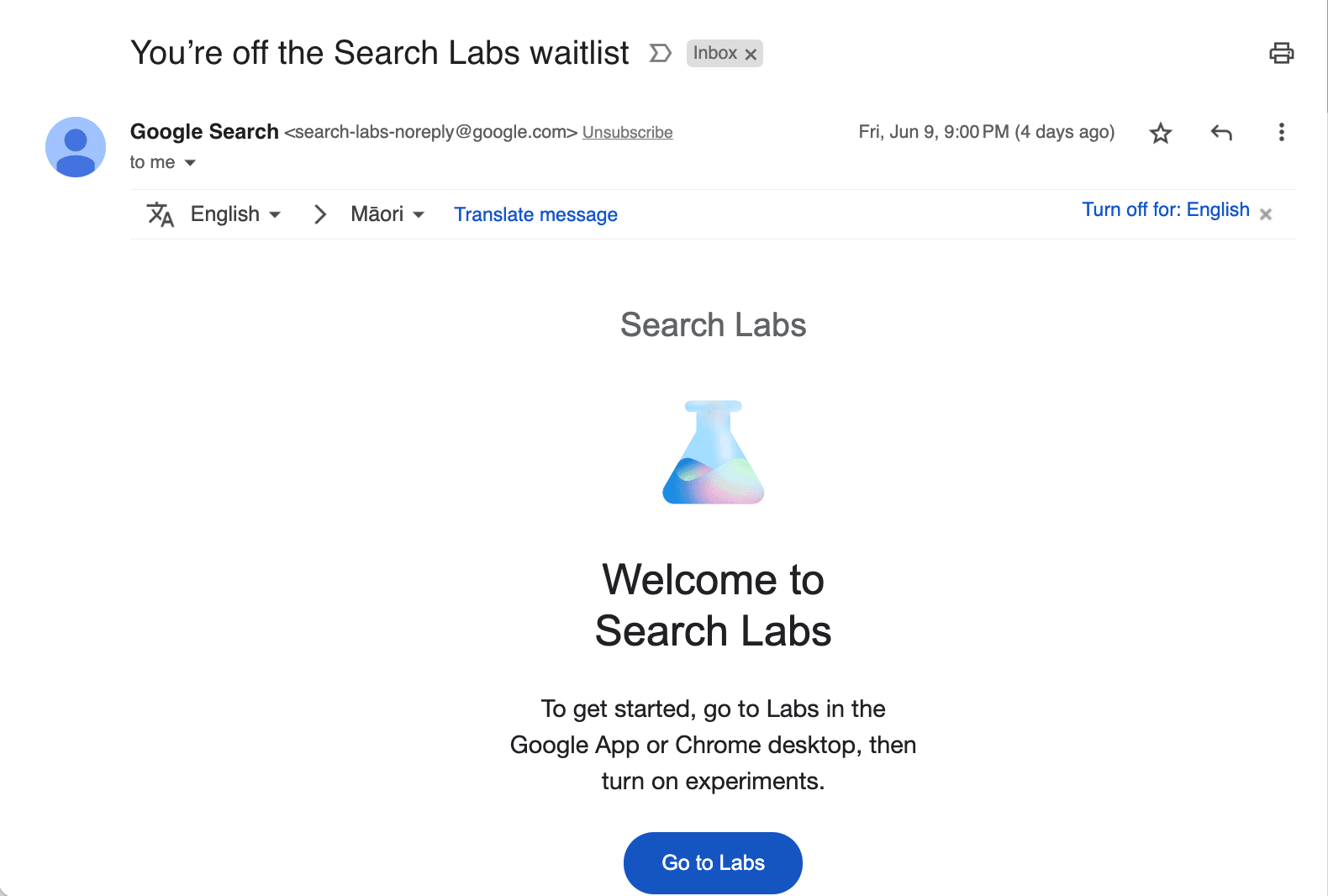
Many of the insights we will provide in the following sections are based on the information shared by early adopters of SGE. A special thanks to Lily Ray, Barry Schwarz, Kevin Indig, Aleyda Solis, Brodie Clark, and Cyrus Shepard for all the observations they generously highlighted in their posts and articles.
How SGE differs from the current Google SERP layout
A major thing that makes SGE stand out is the interactive AI-powered snippet at the top of the SERP. It features an answer to the user’s query and a carousel of websites that SGE used to corroborate the response, with three websites visible by default. The snippet may take a few seconds to generate a response to your query as the AI algorithms are at work.
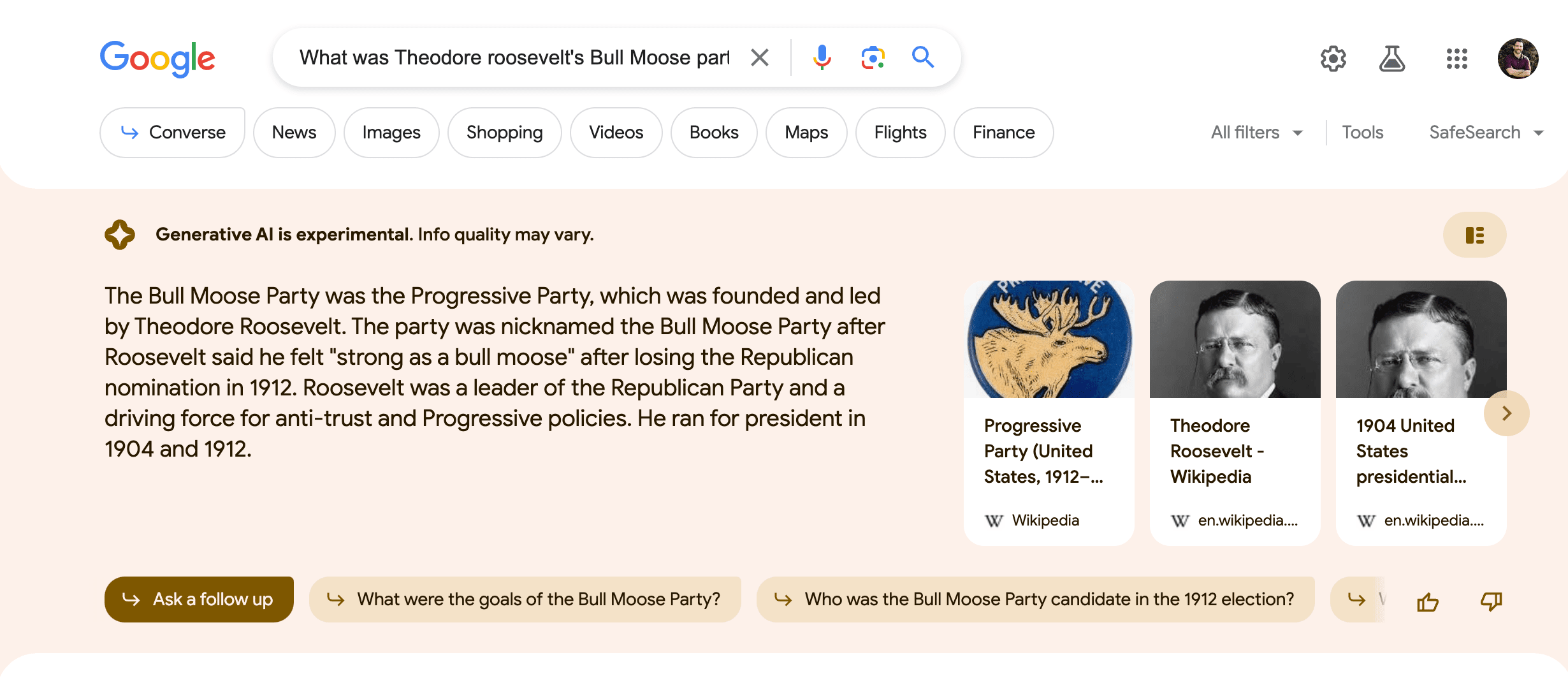
The snippet comes with a vibrant background and can vary in color, potentially included in shades of red, green, blue, lilac, etc. You have an opportunity to ask follow-up questions. Sometimes—like in the example above—the snippet already includes ready-made follow-up ideas. In other cases, Google may not provide any pre-populated ideas, but you can always hit the “Ask a follow up” button.
While the snippet includes links to the websites used to corroborate its response, some SEO specialists reported that SGE isn’t very good at source attribution. We’ll cover more on that later.
And unlike Bing, SGE doesn’t clearly indicate the sources of all the cited information. For comparison, here’s what Bing does:
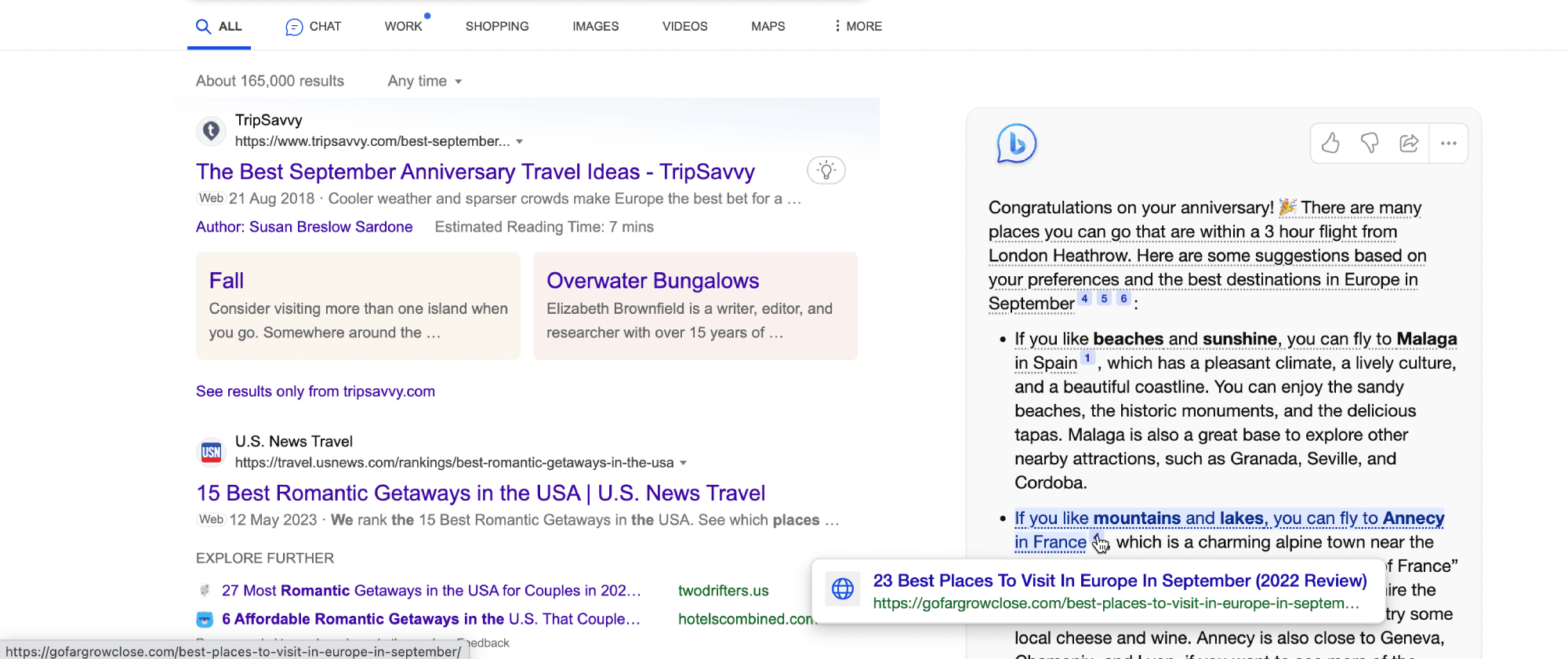
At the same time, when you switch to the expanded mode, the source attribution improves:
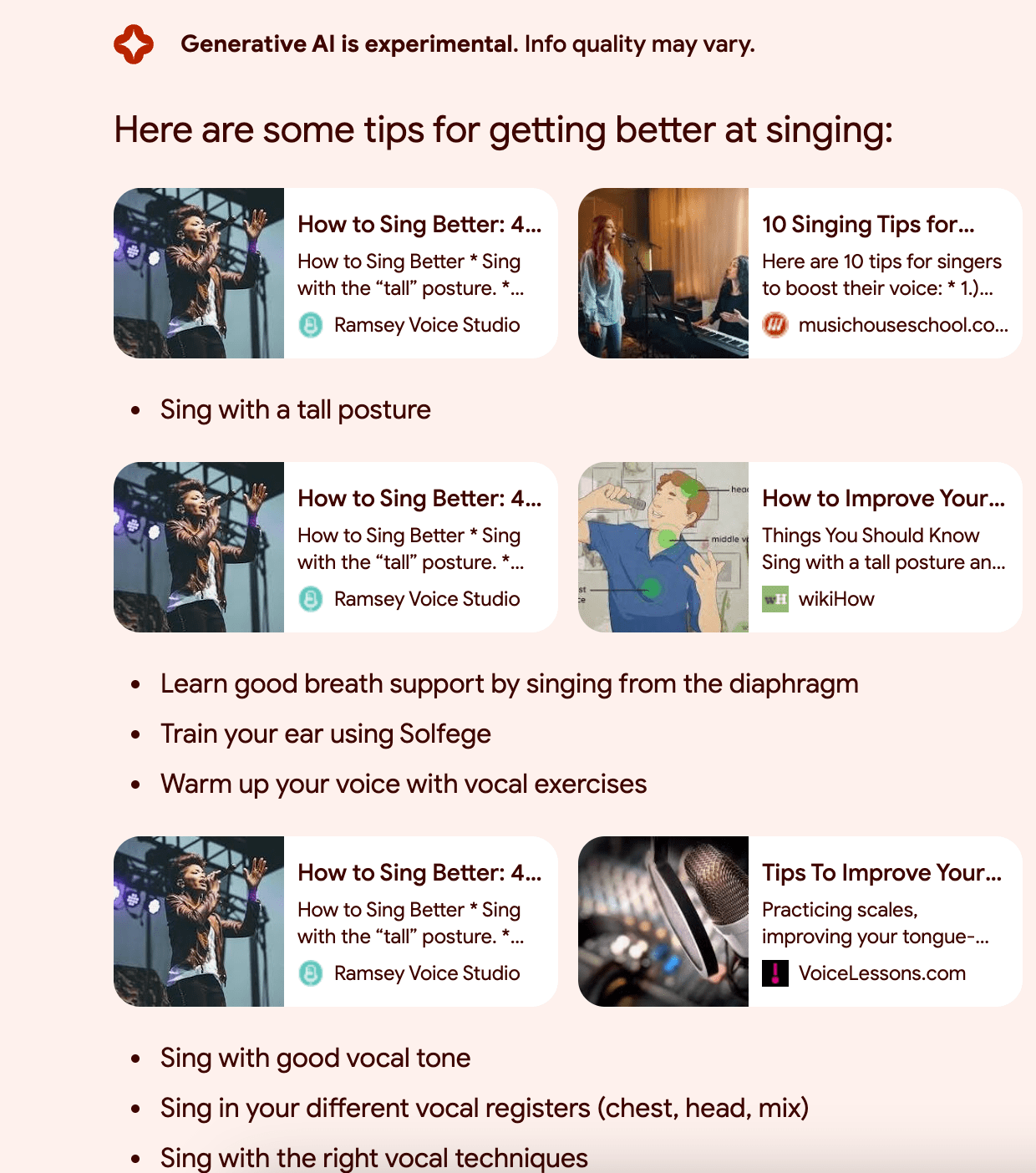
AI-generated responses may occupy a relatively moderate amount of the SERP real estate leaving plenty of space for traditional blue links, especially when the full snippet is hidden under the Show more button.
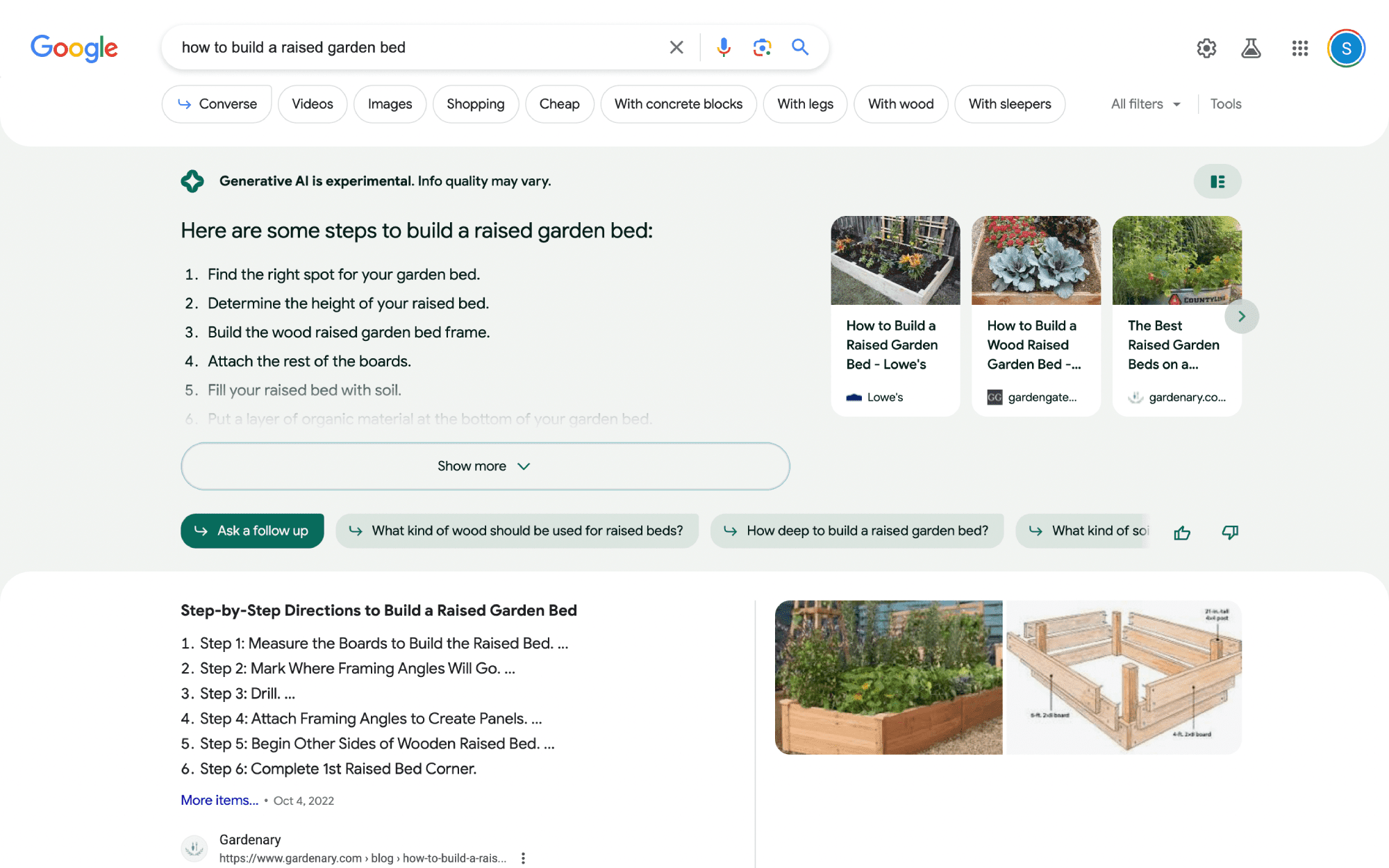
Without switching to full-screen mode, these moderate-sized snippets can occupy the whole first screen, and the temptation to hit the Show more button may outweigh the desire to scroll down.
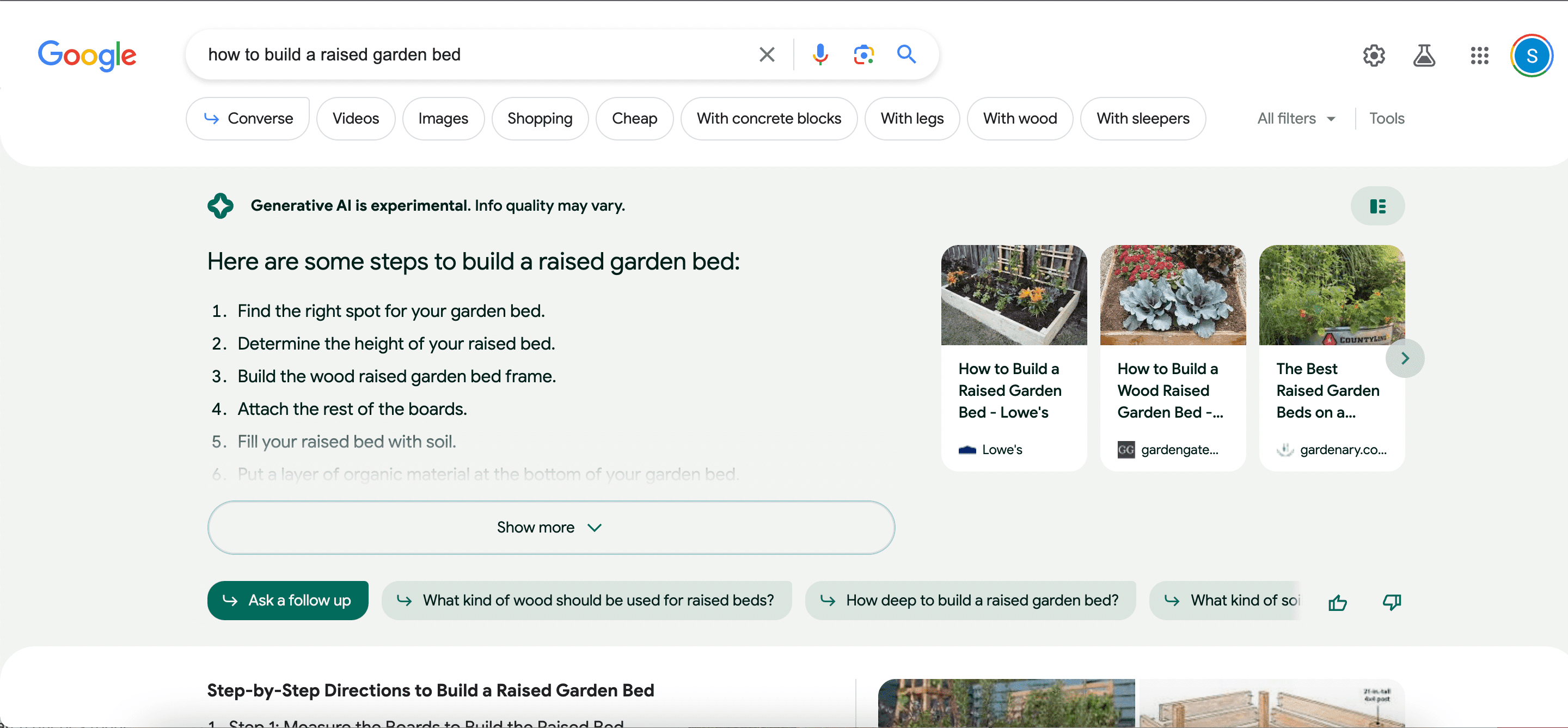
In many cases, the snippets can become quite large, featuring a text response and multiple products that SGE deems relevant to your request.
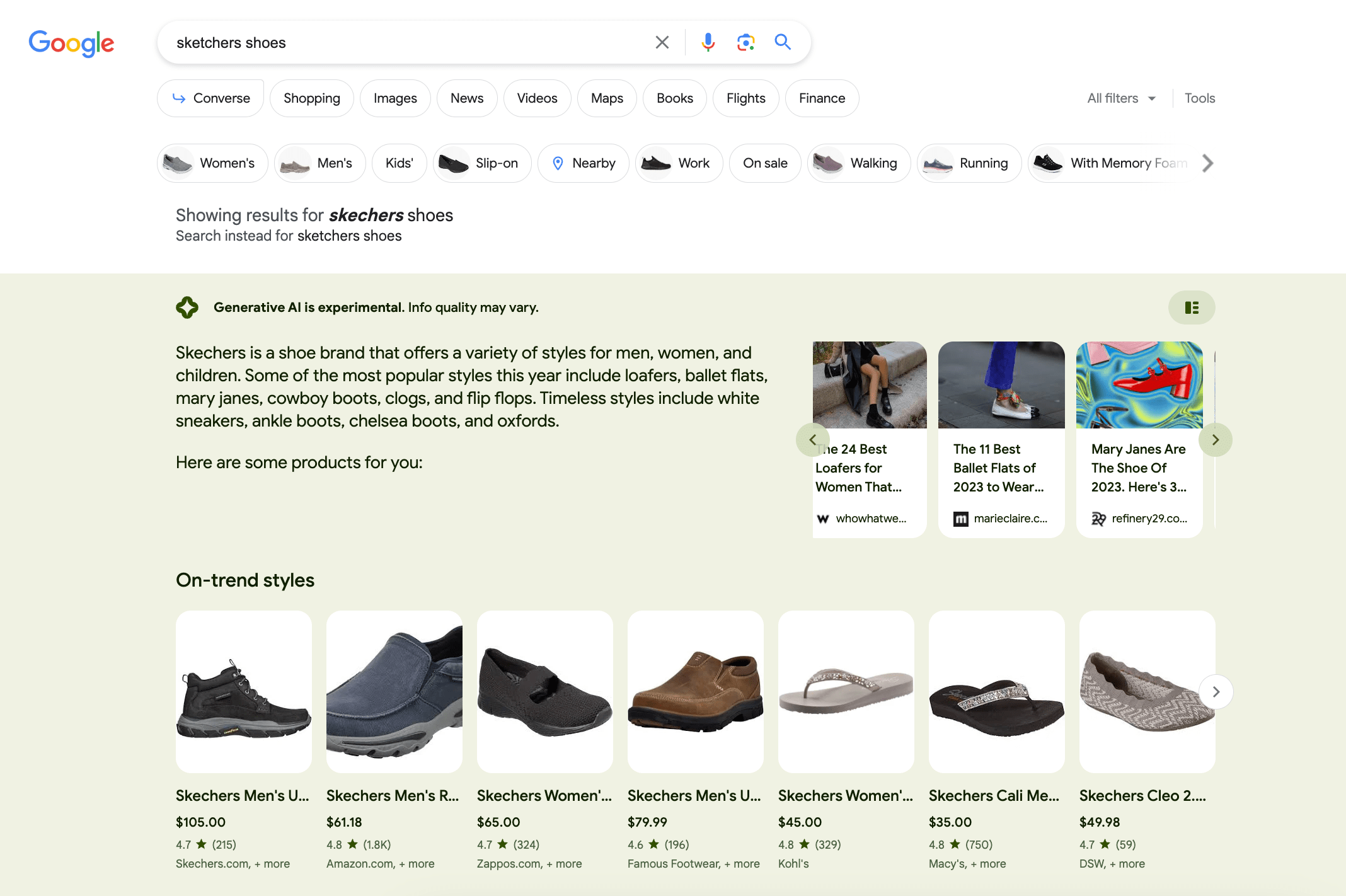
Also, if you ask a follow-up question, the SERP will show both generated snippets during your conversation, taking up even more SERP space.
Generative AI snippets vary depending on the type of search query, and one can draw parallels to traditional SERP features:
- Informational searches trigger snapshots similar to featured snippets.
- Local searches results in generative AI producing a response formatted similarly to a local pack.
- Ecommerce keywords prompt Google to showcase various products, resembling product carousels.
Regardless of search type, AI snippets include a carousel of sites in the top-right corner. The three visible links will probably get the lion’s share of traffic. The difference between various snippet types lies in the presentation of the AI response and extra details featured in the snippet, such as ecommerce products, photos, reviews from GBP, maps, etc.
Now, let’s briefly explore each major type of AI snapshot you may encounter:
General informational queries
General informational queries generate a SERP snippet with a textual response, a few links to the source websites, and suggested follow-up questions.
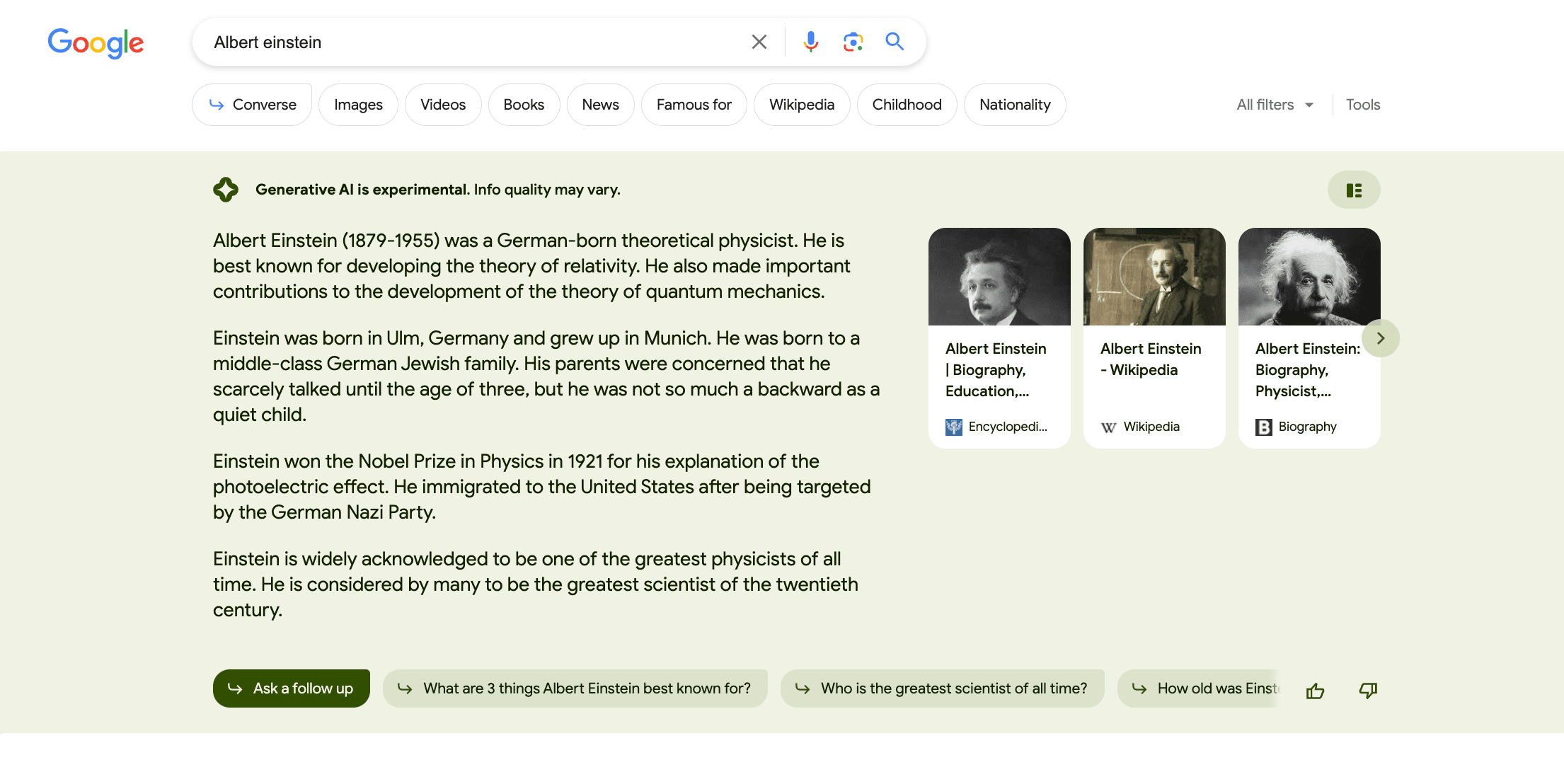
How-to queries generate similar results, but the information is often presented in the form of a list.

Informational AI snippets may include images, such as the ones in the screenshot below.
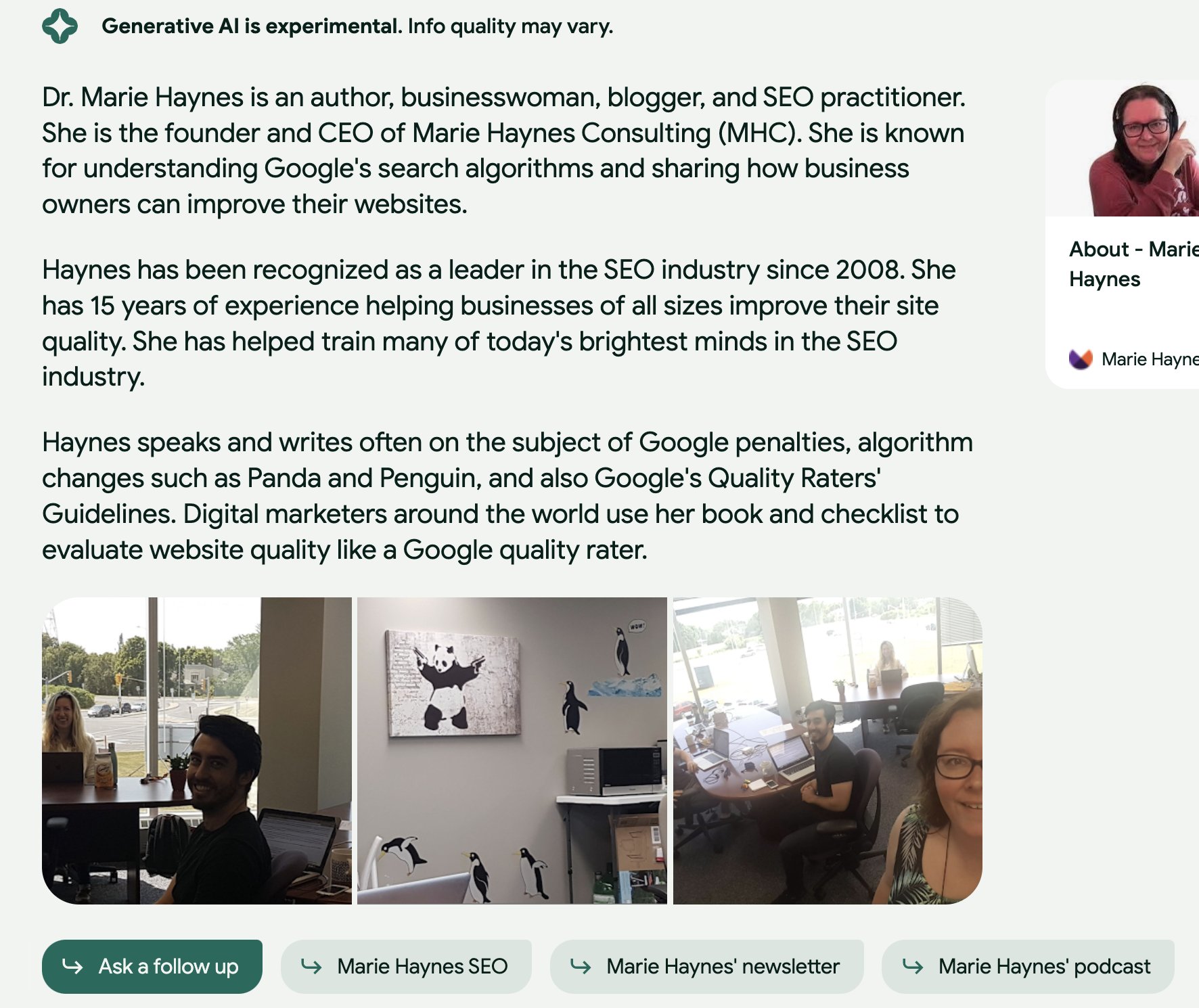
The fascinating thing about this example is that Google pulled Marie Haynes’ photos from her company’s Google Business Profile page. This shows that Google uses all sources of information out there, and then combines information pulled from multiple sources to generate the most helpful responses.
Another interesting element that SGE tends to include in the snippet is quotes from GBP user reviews. This happens when you search for places like Google’s London office, Taj Mahal, or Search Labs. In most cases, the snippet will also include pictures, although Search Lab’s GBP profile evidently lacks them. Interestingly, a map is not included in these instances.
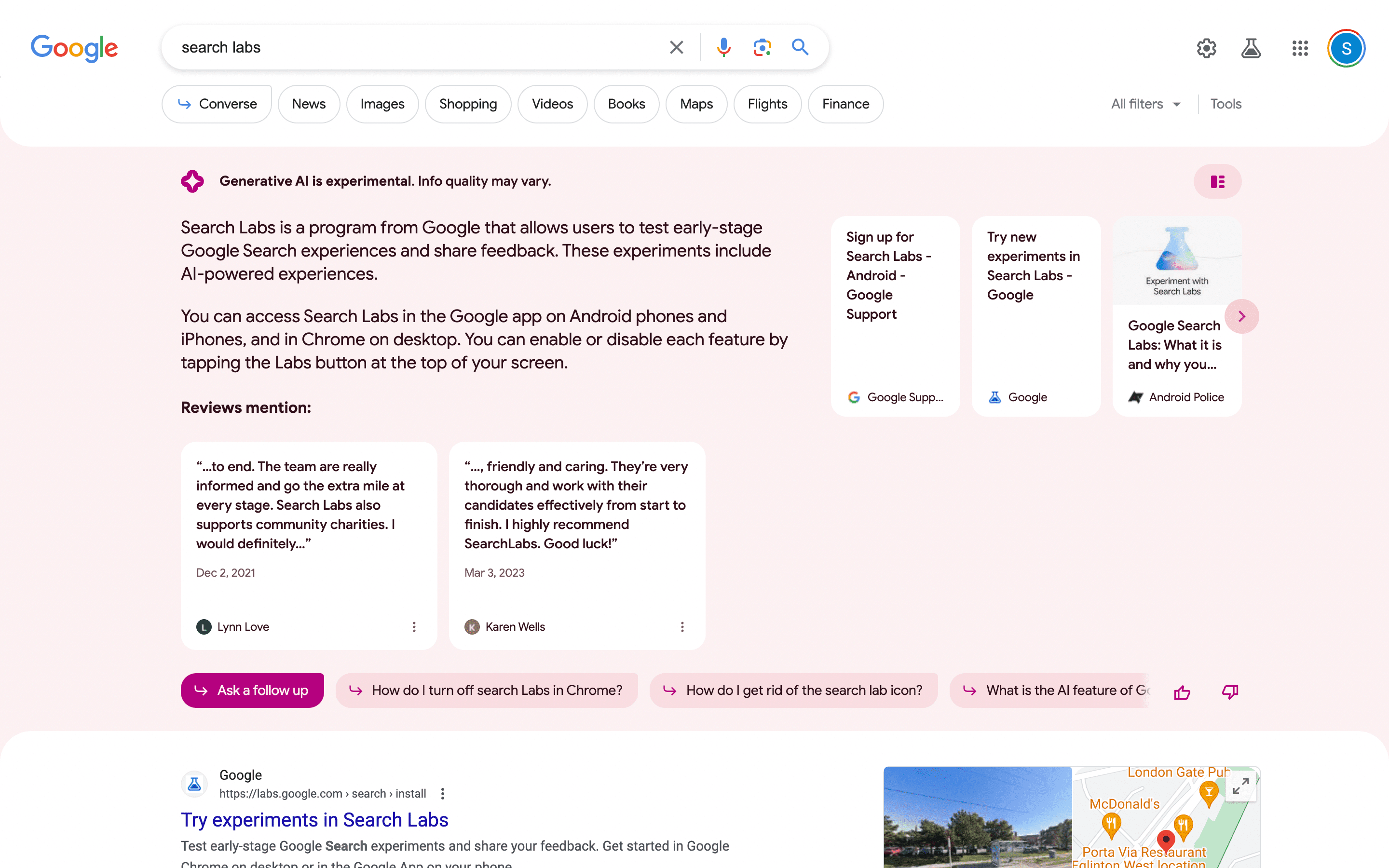
Listicle-type informational queries
Search queries that are best answered with listicle articles trigger a slightly different type of snippet, featuring a list of suggested solutions along with their short descriptions.
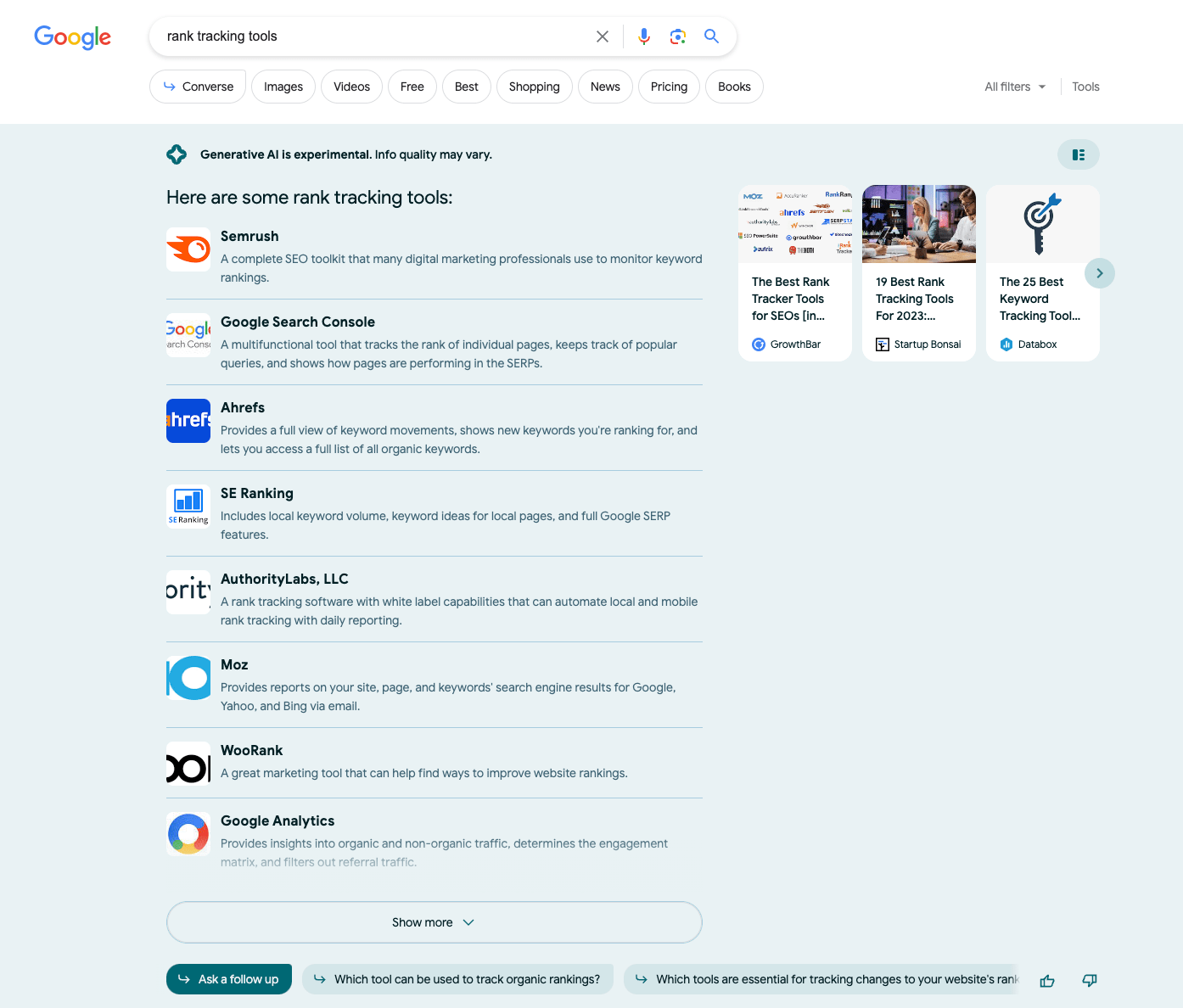
Sometimes, this list of solutions can be combined with a textual response presented as a bullet list. Additionally, the snippet may include a map if SGE decides your query has a local context.
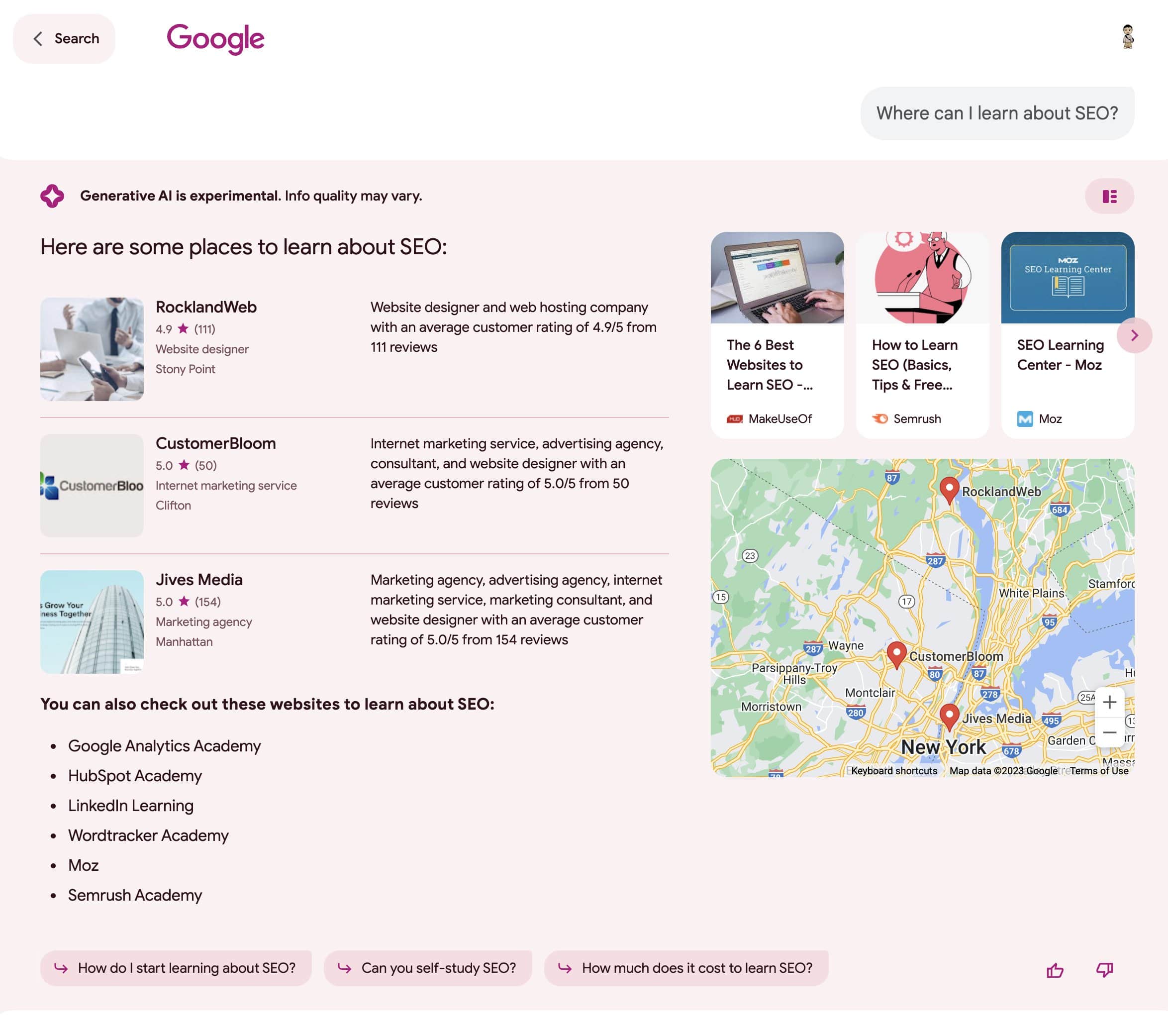
Interestingly, SGE has made changes over time, as the same query no longer shows the map and list of local businesses:
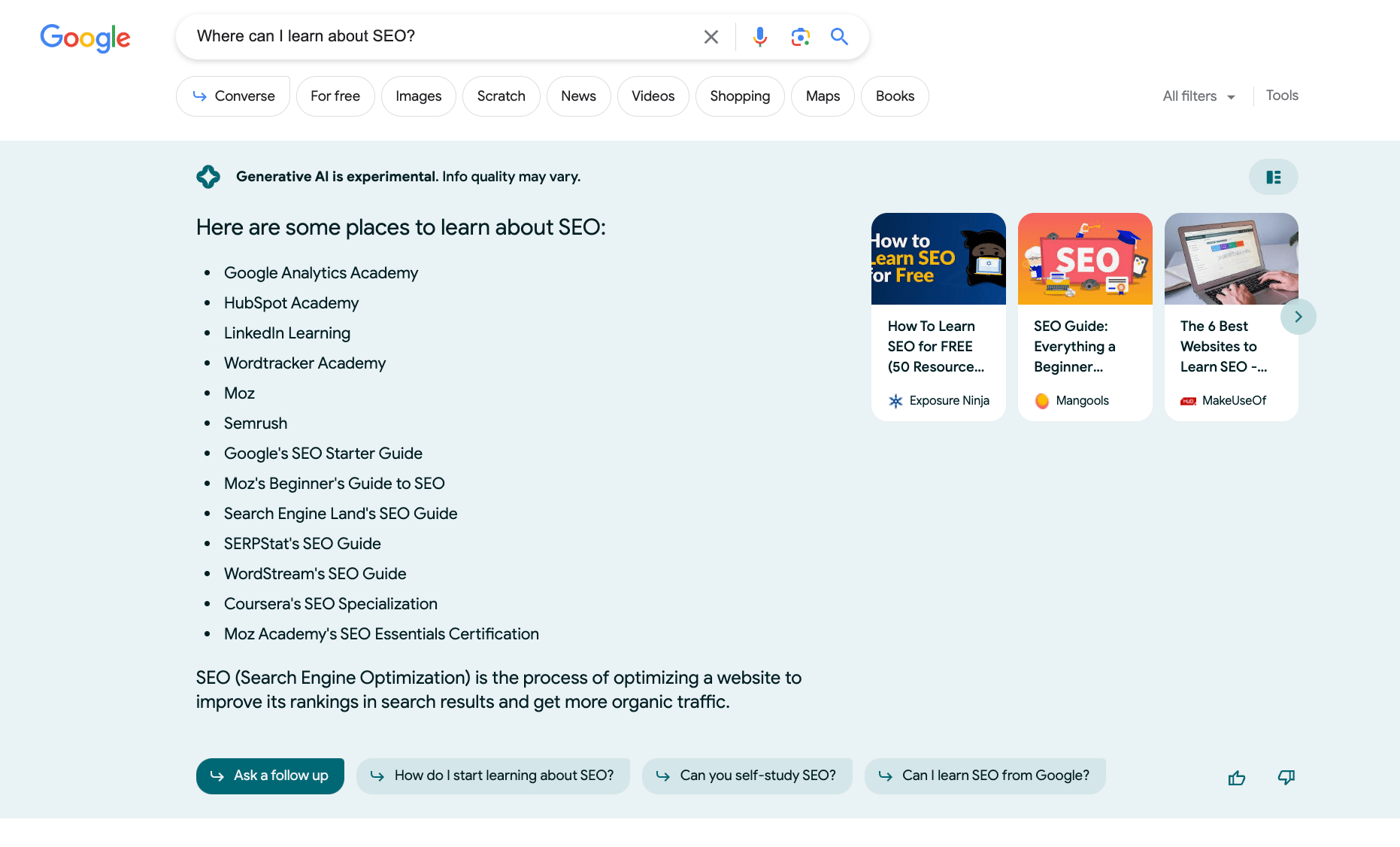
Local queries
Search queries that clearly indicate a local intent generate snippets that look much like the Local Pack. However, these snippets can feature up to five listings, whereas a traditional Local Pack displays only three.
AI snippets with only three listings were spotted as well:
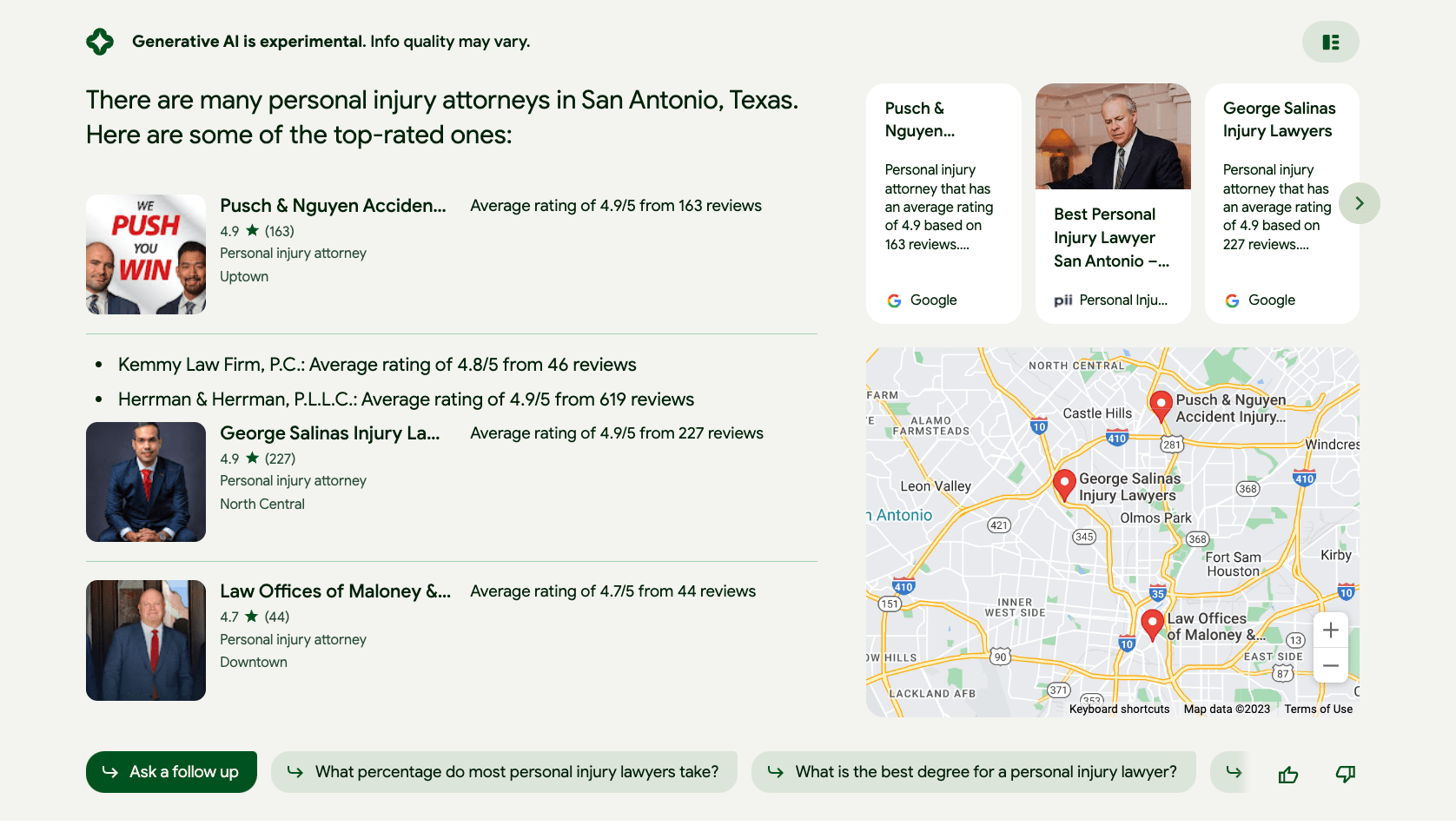
Ecommerce queries
Ecommerce searches often result in snippets containing textual advice on selecting the desired product and a list of products that SGE deems suitable based on your requirements. Each listed product comes with a short description.
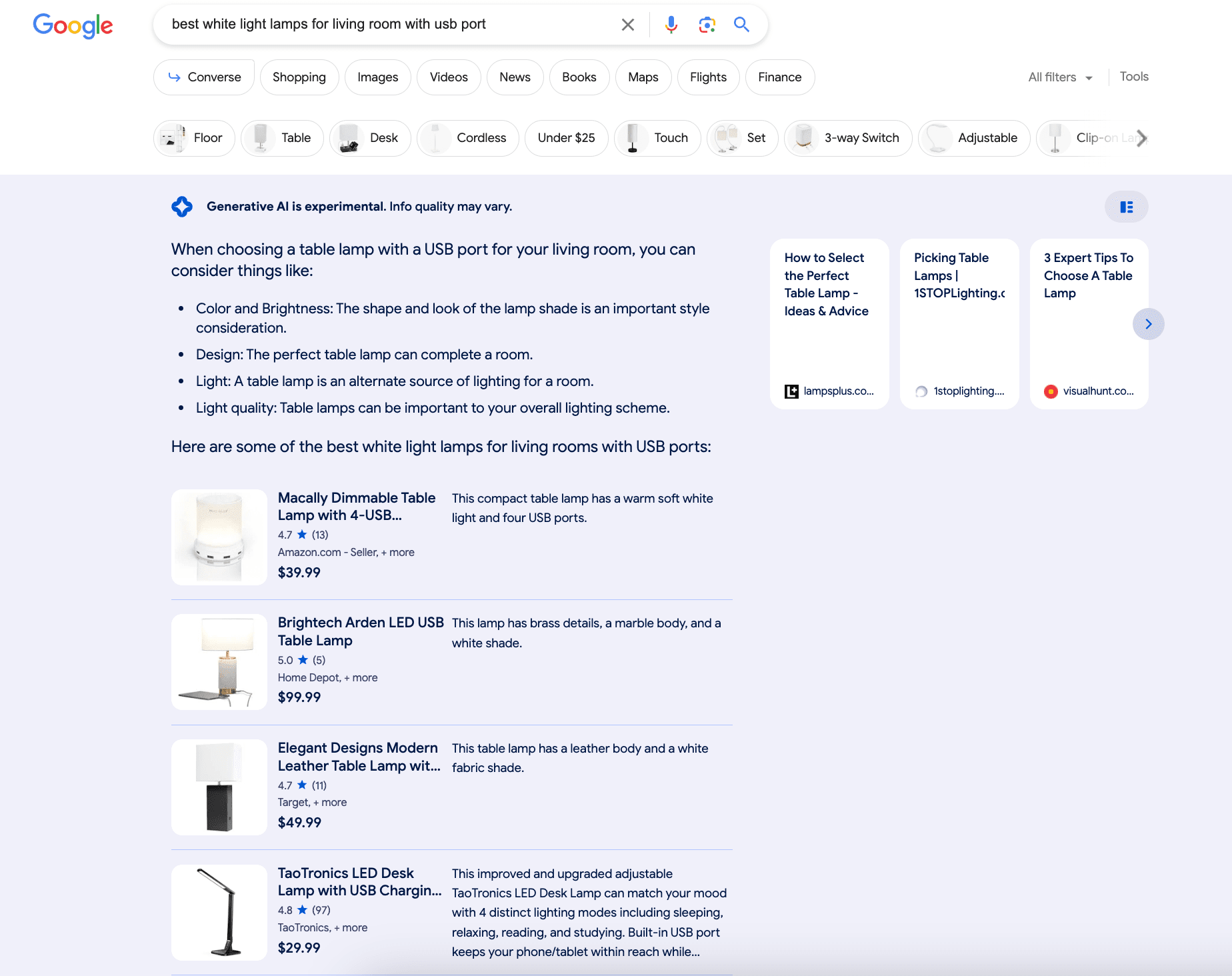
As Lily Ray noted, these snippets may contain plenty of links to “top products” articles. On mobile devices, they’re placed at the bottom of the snippet:
An interesting observation by Kevin Indig is that SGE appears to use user reviews to make specific product recommendations, such as identifying standing desks that are “good for home” or “good for tall people”:

If your query combines commercial and informational search intents, you may see a snippet that looks like this:
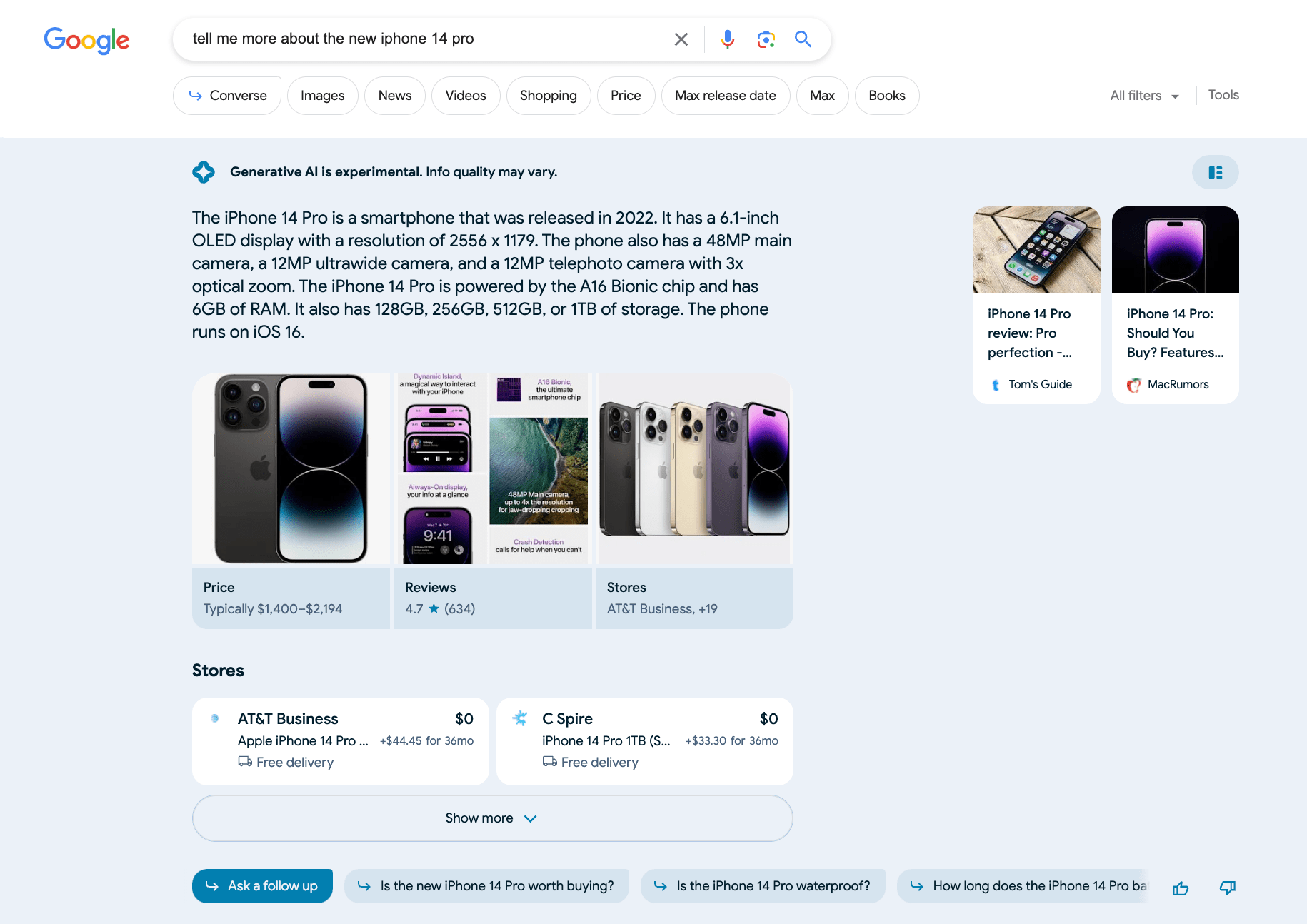
The snippet resembles those generated for informational queries but includes product images and links to the store (Please note that the screenshot above displays a brand store and not a reseller. Unfortunately, this isn’t always the case).
It also appears that SGE will be integrated with the Merchant Center, allowing for more detailed information about suggested products and the list of stores it can be purchased from.
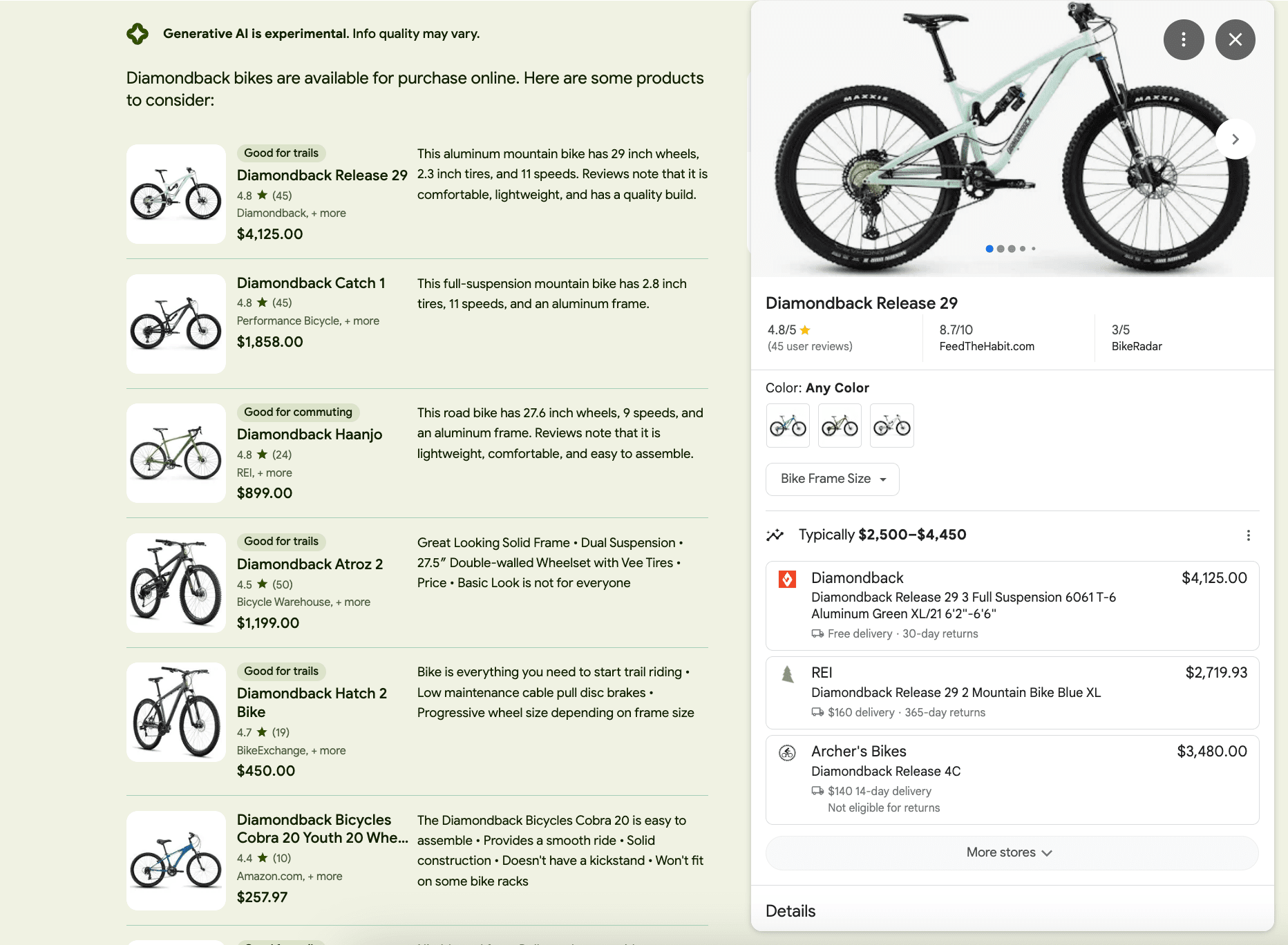
For now, the feature doesn’t always work smoothly:

Do all search queries trigger a generative AI snapshot?
The short answer is no. Cyrus Shepard managed to single out seven categories of search queries that do not trigger AI snippets:
1. Navigational queries like Facebook or Amazon, although there may be exceptions.
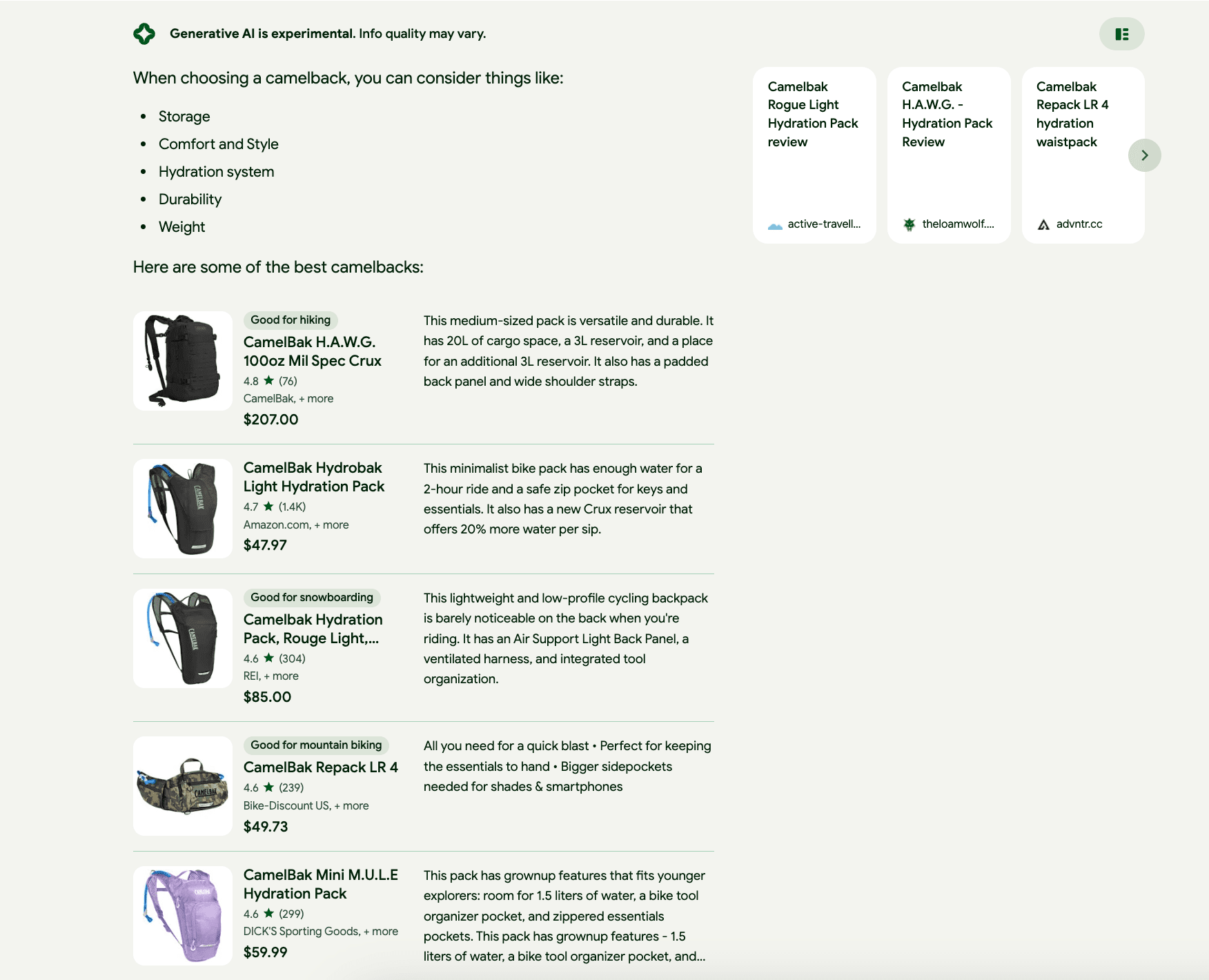
2. Quick Answers, such as weather forecasts or song lyrics.
3. Sensitive queries related to topics like “gender identity,” or “holocaust”. However, not all controversial topics are considered sensitive:
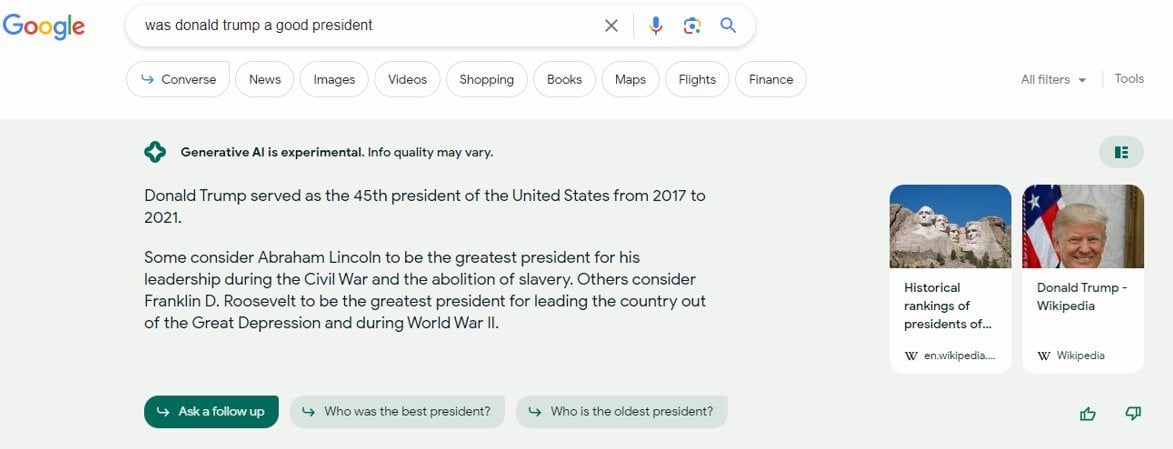
4. News and current events.
5. Recipes, which is a bit surprising.
6. NSFW/explicit/**** queries.
7. Many of the YMYL queries, such as searching for the “best credit card for poor credit score” or the “best place to buy ketamine” won’t display an AI snippet. Oftentimes, though, SGE would generate answers for queries that could be considered YMYL. It is happy to list “diaper rash symptoms”, and “mortgage rates”, give advice on how long copyright protection lasts and even offer advice on “whether headaches can be a sign of cancer”. On all occasions, SGE would add some sort of disclaimer stating that the information provided cannot be considered medical, financial, or legal advice.
Messages you can get if AI search is not available
Note that depending on the type of query, SGE may suggest that you “Get an AI-powered overview of this search” or it would state that “An AI-powered overview is not available for this search.”

Here’s an example of some navigational and news searches where SGE believes that an AI response may not be the most relevant for the user, but it could still generate it if requested. Google likely assumes that an AI overview of the search would do no harm in such cases.
In some cases that are particularly sensitive, SGE provides no message at all and offers a regular SERP instead:
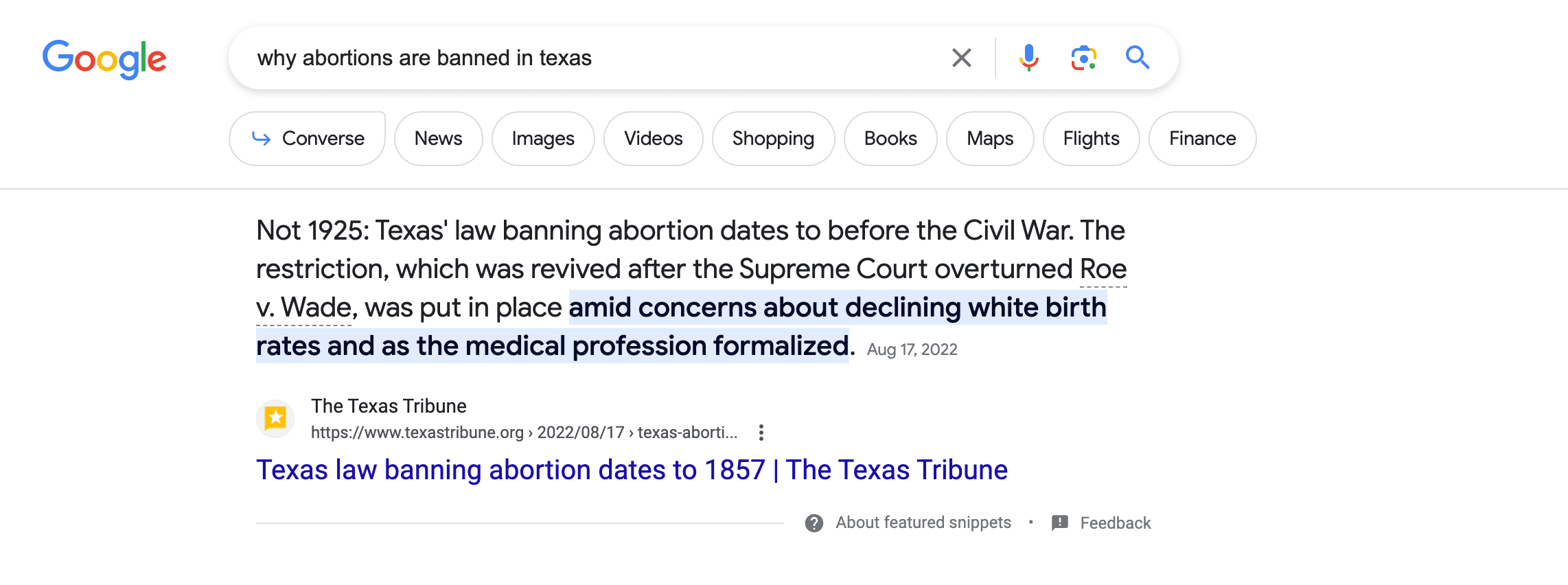
If you enter conversational mode, it will display a “Here are some results” message still not giving you the opportunity to generate an AI snippet:
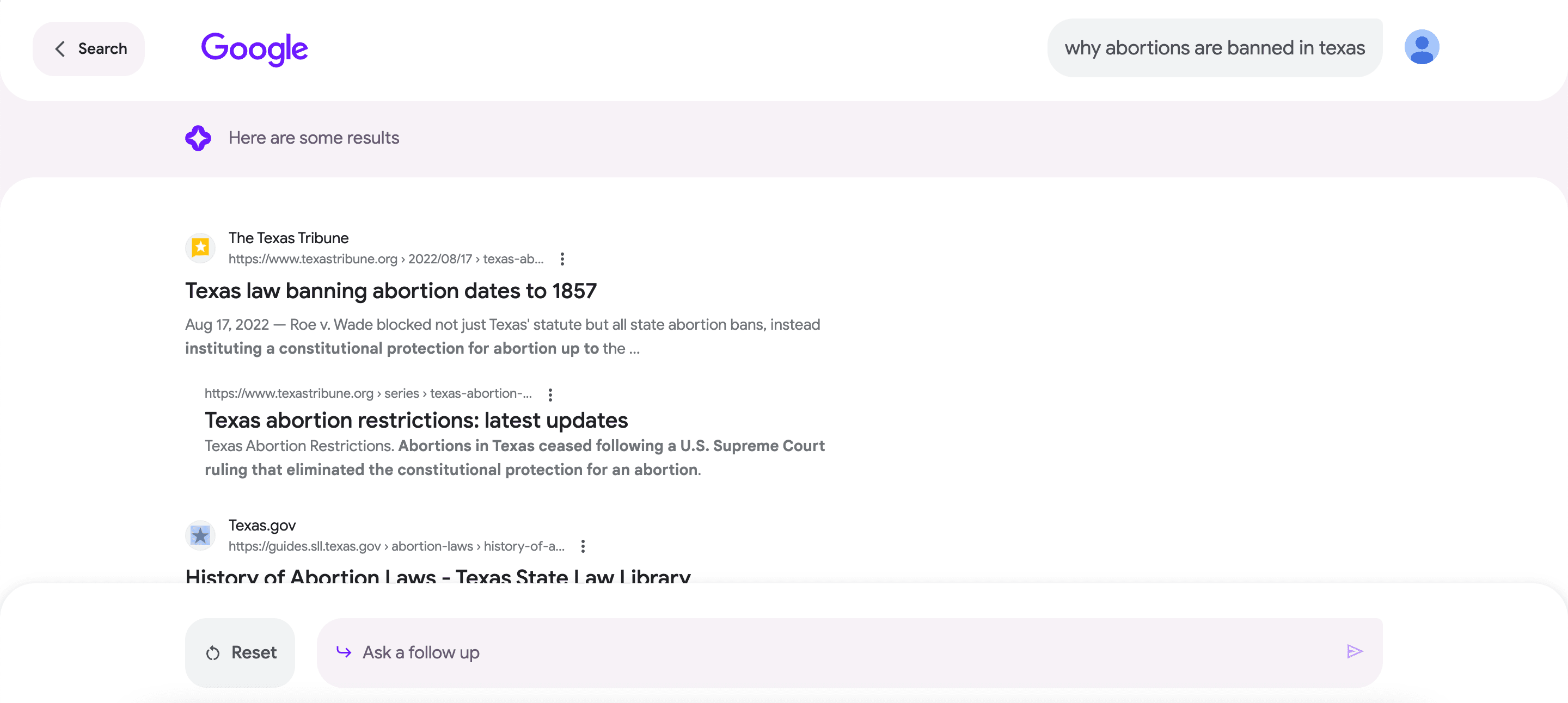
And in some cases, SGE may offer to generate an AI snippet, but then change its mind and display a “no AI overview is available” message:
Which SERP results are cited and linked to in the generative AI snapshot?
Maybe your first guess is that SGE uses top-ranking search results to generate AI snapshots, similarly to how it generates featured snippets.
But based on what we can conclude from the first weeks of testing, this is not the case.
Google would often pull the AI response from websites that are not currently ranking high. This includes “smaller players” and even “random, questionable sites,” as Lily Ray puts it:
Some good news about SGE for SEO, I guess, is that random, questionable sites – that most definitely weren’t ranking in top results before – somehow seem to be frequently selected as references in SGE answers…
— Lily Ray 😏 (@lilyraynyc) June 2, 2023
SEO specialists offer theories explaining the reason for this, ranging from “SGE not using all the ranking systems that search uses when deciding what to look at” to assumptions that Google prioritizes content credibility “at the creator/author of content level.”
Kevin Indig even suggests that it’s possible to reverse-engineer AI results. After clicking the links in the carousel, a user will land on a specific passage that Google used to form the AI snippet, which is a process that works similarly to featured snippets.
By analyzing several SERPs, Kevin concluded that the unique angle of your content needs to match what the AI snapshot puts emphasis on.
Kevin uses the “corporate credit card” SERP as an example, where, SGE focuses on building its response around the subject’s benefits and risks for businesses:
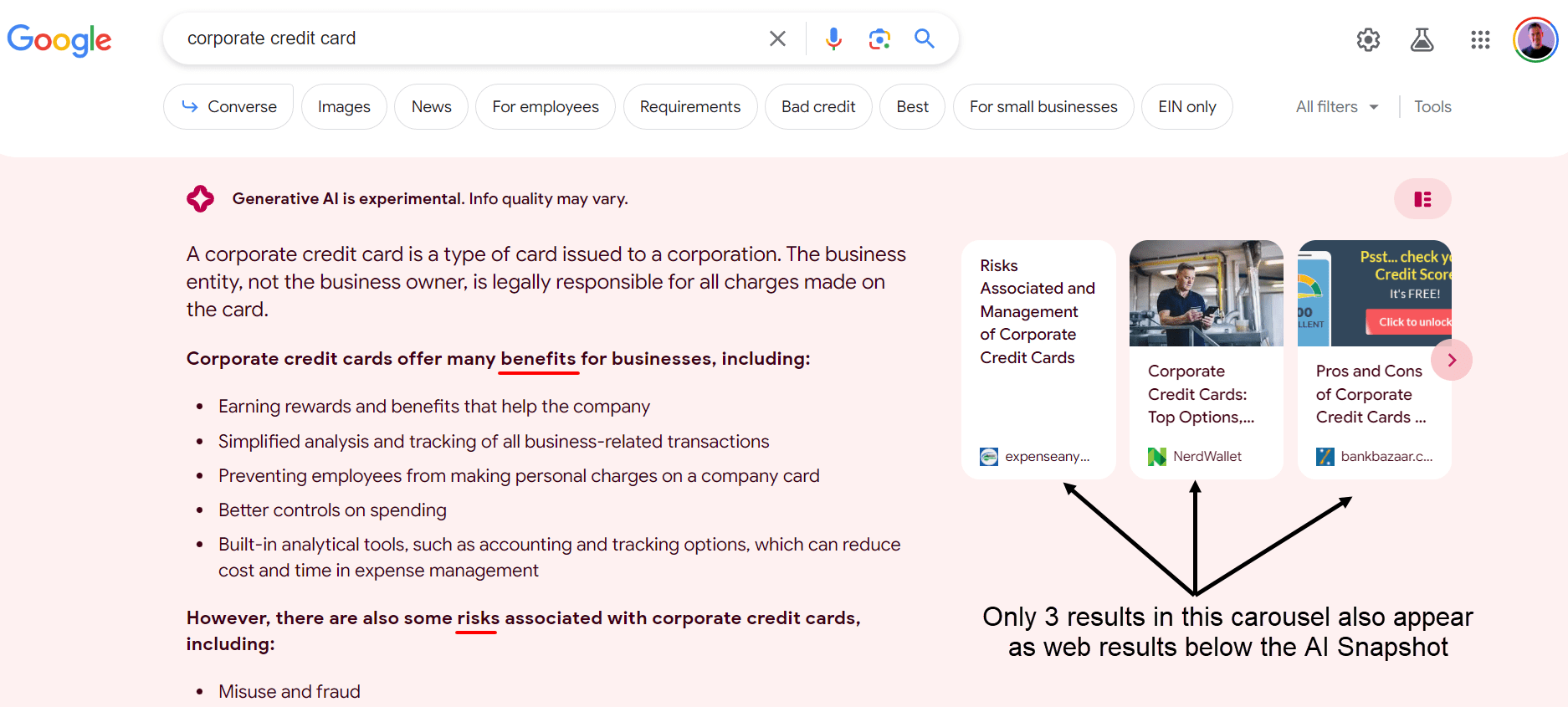
In the snapshot above, you can see that the AI pulled the risks section of its response from the ExpenseAnywhere website, which ranks 26 in non-AI search results. The reason for this is that this particular content piece covered the specific angle that SGE was interested in:
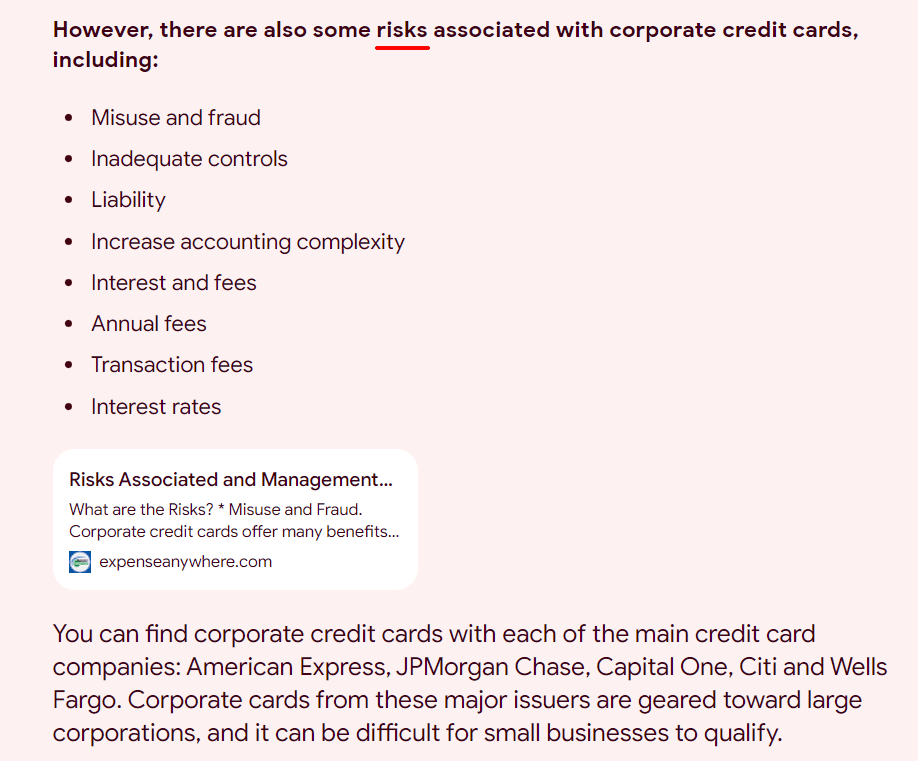
While the exact reasons for SGE’s selection of certain angles for certain topics are not currently known, spotting patterns that work in your industry with different types of queries can help you incorporate relevant information to your content and increase your chances of making it to the carousel.
Are SGE search results personalized?
In one of her tweets, Lily Ray reached out to Google to ask if SGE search results were personalized. Google’s response was a definite no. According to Google’s reps, the context of the whole conversation is taken into account and search results can vary depending on your previous queries. That being said, your previous search history will not impact the SERP.
Where would Google Ads go?
Google Ads are definitely not going anywhere. Google needs ads to make money and will eventually incorporate them into AI-generated snippets.
As indicated in a preview published on Google’s blog, ads will naturally blend into the SGE landscape just like how they fit into the non-AI search.
But that is a development for the future.
For now, as we are at the early stages of testing, Google Ads are not yet included in the AI snippets, and you can spot all sorts of SERP layouts, including:
- Google Ads placed above the AI snippet. Oftentimes, this means that the snippet was not initially there, but you clicked on the “Get an AI-powered overview of this search” button. While this placement was common during the first days of SGE testing, it is no longer as widespread.
- Google Ads placed below the AI snippet.

- Some SERPs do not include Google Ads but feature plenty of sponsored snippets in non-AI search results:
- In local searches, AI-powered SERPs do not contain sponsored links, while non-AI SERPs may have plenty of sponsored links:
What will happen to existing SERP features, such as featured snippets?
As of now, various SERP features, including featured snippets, are still part of the SERP. Interestingly, featured snippets were spotted to be positioned directly below the AI snippets, which may seem counterintuitive as both serve as quick summaries of the topic.
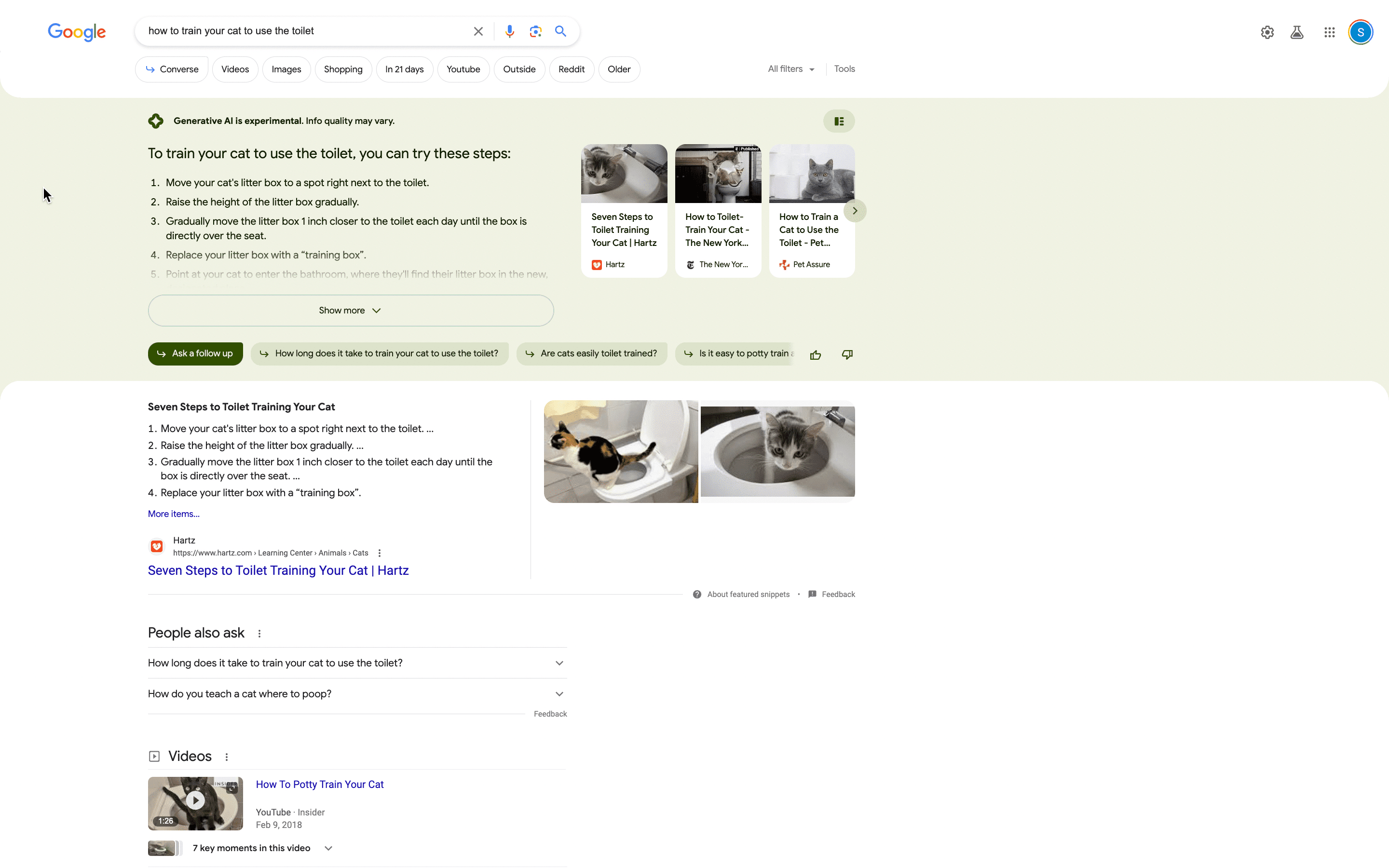
In the provided screenshot, other familiar SERP features like the People Also Ask box and videos are still visible. The same goes for rich snippets, knowledge graphs, top stories, events, recipes, and other popular SERP features.
However, some SEOs believe Google will eventually remove certain SERP features like featured snippets or local packs. This is because these features duplicate the information presented within the AI snippet and occupy SERP space for no justifiable reason.
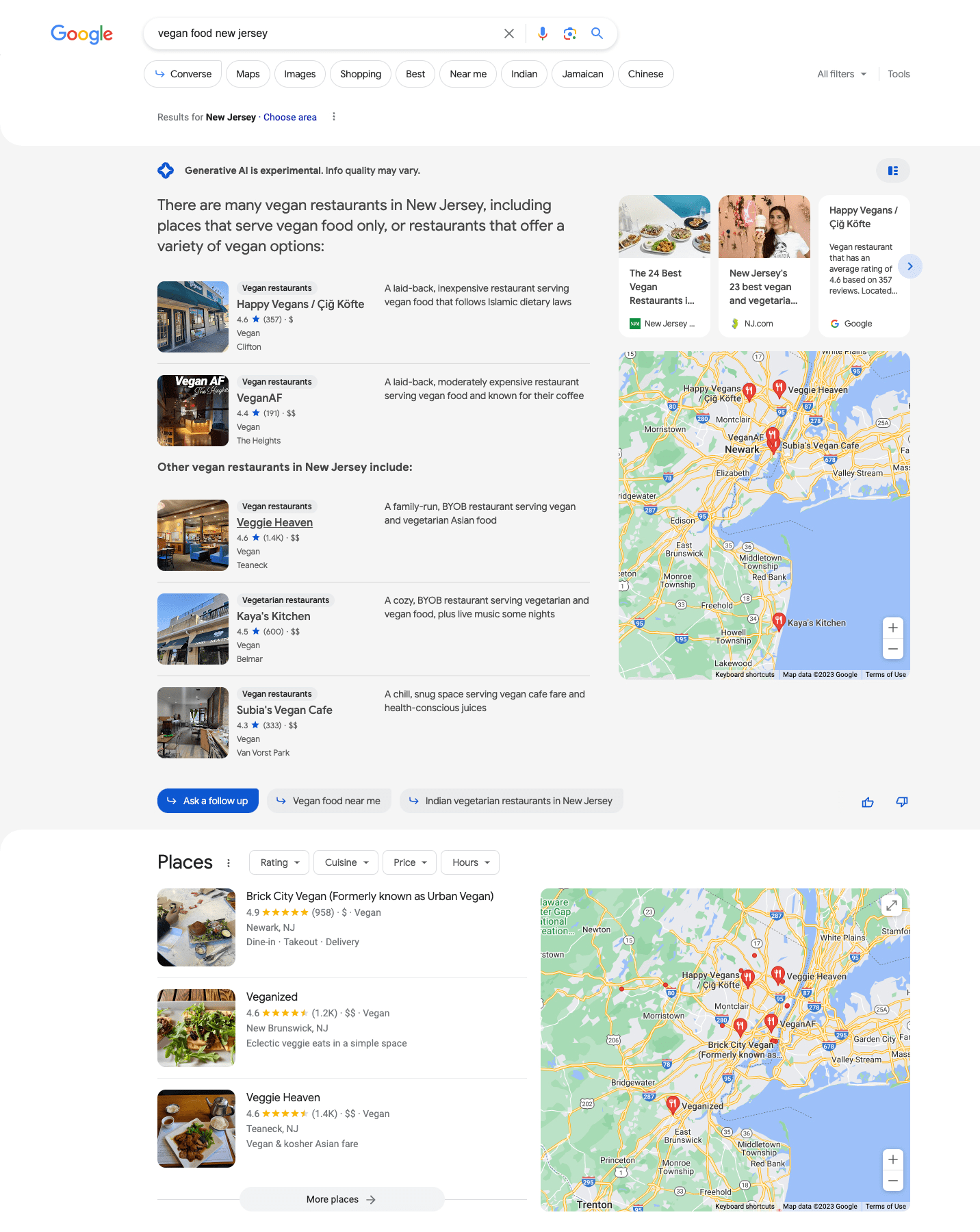
What does the SEO community think about SGE?
Based on the poll conducted by Lily Ray on Twitter, the overwhelming majority of SEO experts are not impressed with what SGE has to offer:
For those who have had a bit of time playing around with SGE, how much of an improvement (or not) do you think it is to Google search?
(Pretend to not be SEOs for a sec, if possible)
(Also imagine it will continue improving in quality ¯\_(ツ)_/¯)
— Lily Ray 😏 (@lilyraynyc) June 1, 2023
When excluding people willing to learn the survey results, only 12% of the respondents consider SGE to be a significant improvement to Google search.
Reported bugs and concerns
The new search functionality is seen as a potential threat to websites that invested a lot into increasing their visibility. However, this is only one among many reasons why SEO professionals are not that excited about the new search. An even bigger problem is the current functioning of the system in general.
Surely, in every AI snippet it generates, SGE clearly emphasizes: “Generative AI is experimental, data quality may vary.” And we should bear that in mind while hoping that many of the things that are obviously faulty now will be fixed in the near future.
Still, it’s important to highlight the many areas where SGE is currently struggling.
Poor source attribution
We already mentioned that unlike Bing, SGE doesn’t consistently or clearly attribute each statement to its rightful source. It also frequently fails to include the quoted article in the link carousel.
This case reported by Brodie Clark was eventually rectified:
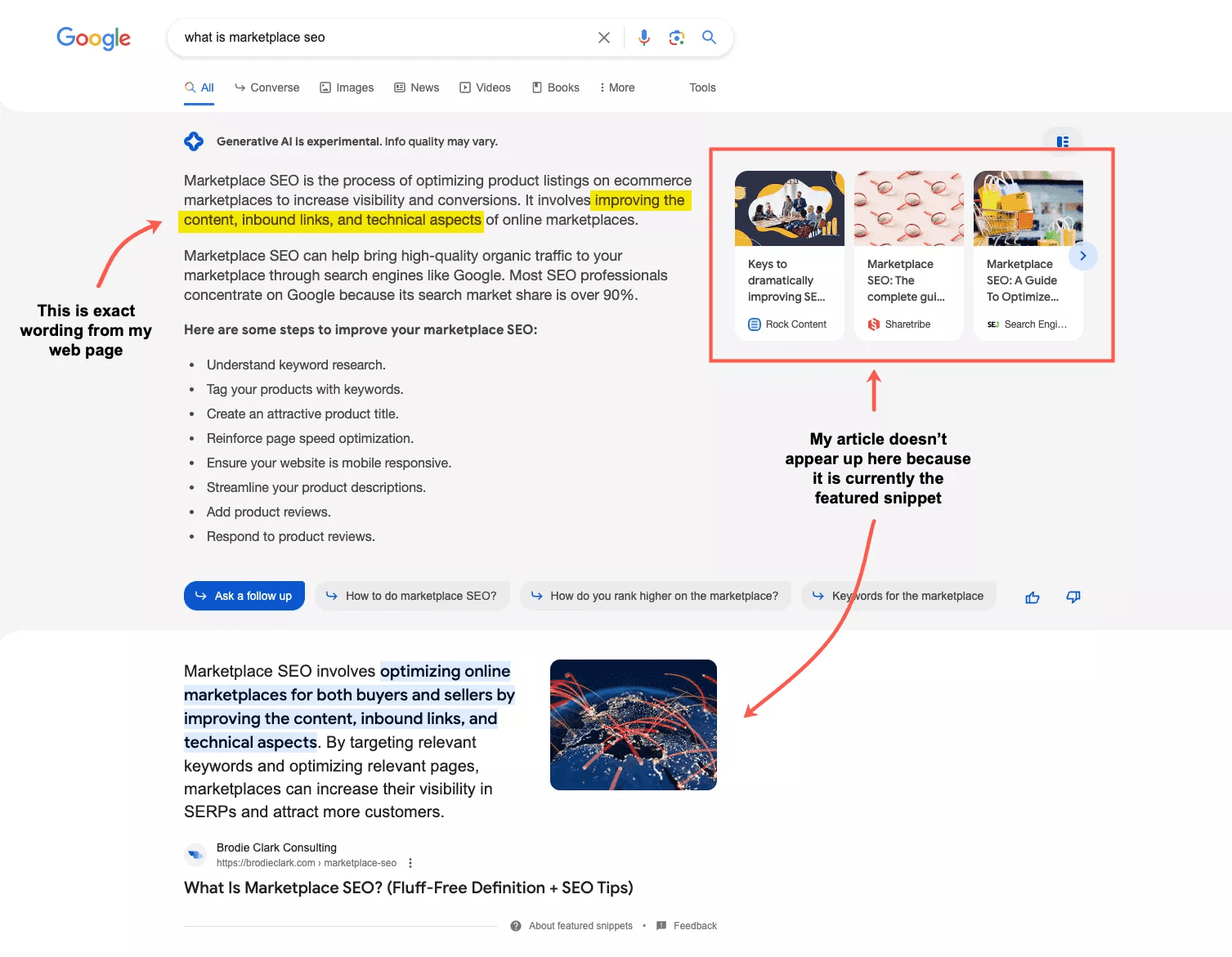
But rectified or not, SGE using expert quotes and presenting them as general truth with no reference to the author isn’t a good look for SGE. This is not a right way to present information.
In response to user tweets, Google claimed that SGE was an experiment and that they appreciated the feedback. They also noted that in the expanded view, source attribution becomes clearer.
Missing links that lead to poor UX and lost traffic
Despite the importance of links on the Internet, SGE doesn’t link back to the websites, products, and services that it mentions in its AI responses.
In the examples below, links to the suggested rank tracking tools and websites that offer SEO training are not clickable, which contributes to a poor experience for users. What concerns SEO specialists even more is that even if their website makes it to the AI snippet, they may not receive a fair share of traffic. This is because users have no option to click on the link and explore the suggested solutions in more detail.
In the following example, you’ll notice that SGE not only fails to link back to the brand website, but even recommends buying a product from resellers instead:
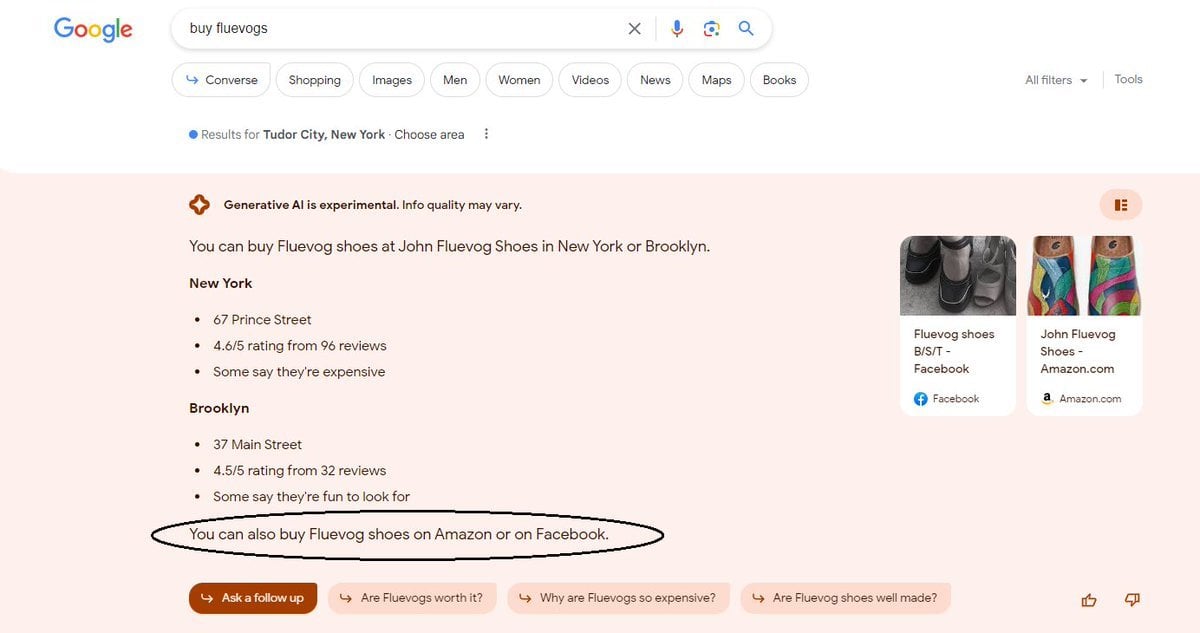
Including clickable links to the products in the snippets, as demonstrated in the example below, would be way more user-friendly. After all, providing easy access to specific products is one of the main reasons why we place anchor links to website pages.
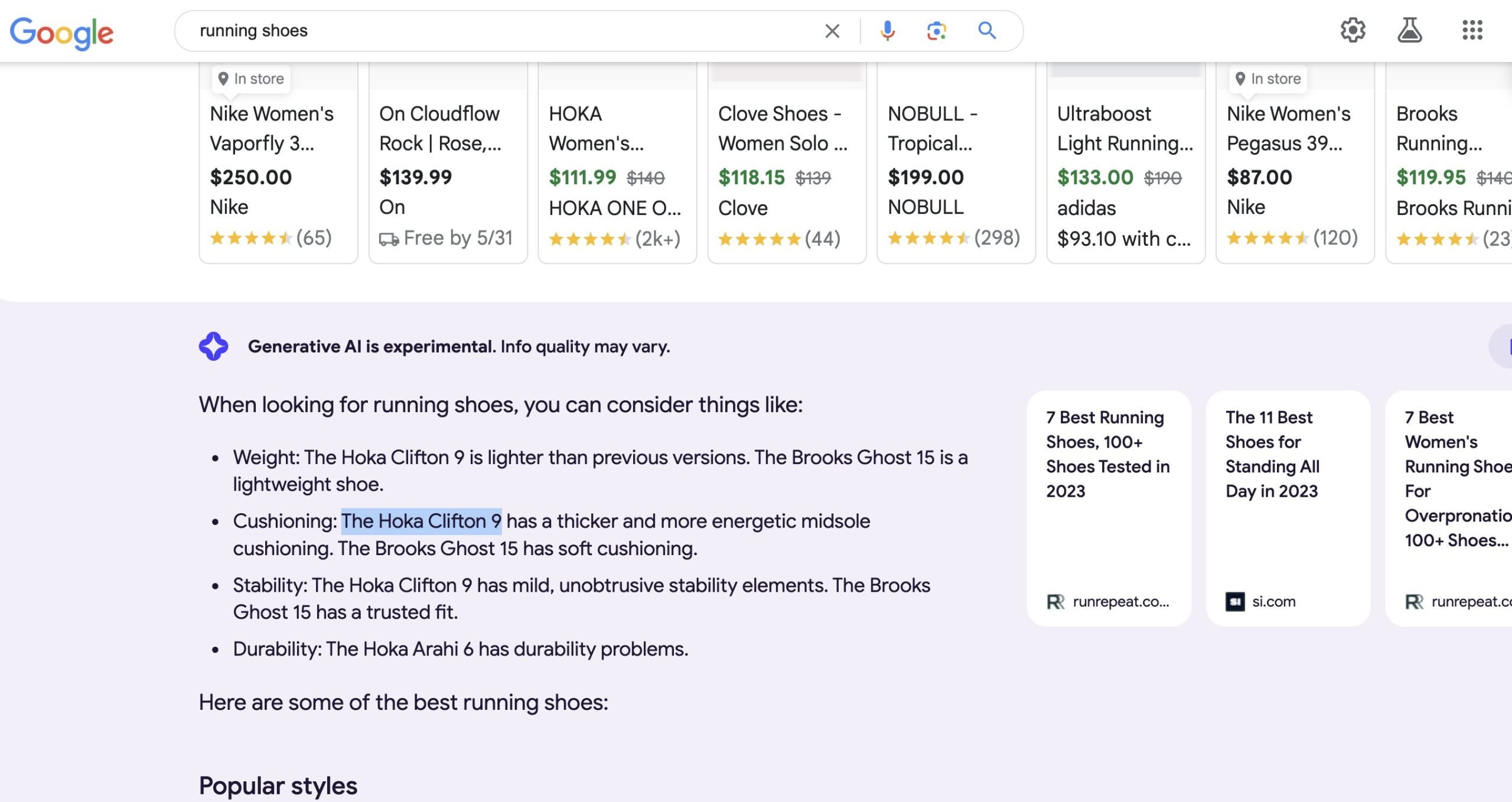
Confusing or false information
You cannot fully trust AI, and Google’s AI-powered responses are no exception.
For example, at one point, it recommended boiling the eggs for up to 60 minutes total:
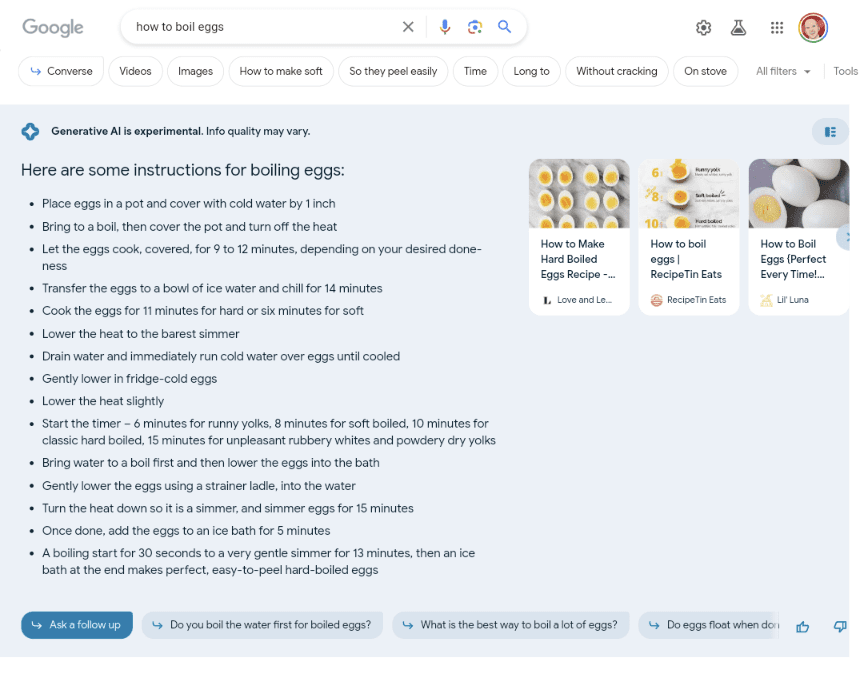
Oftentimes, SGE struggles to align the AI snippet with the user’s intent, such as offering basic info about Caribbean cruises instead of presenting specific cruise options.
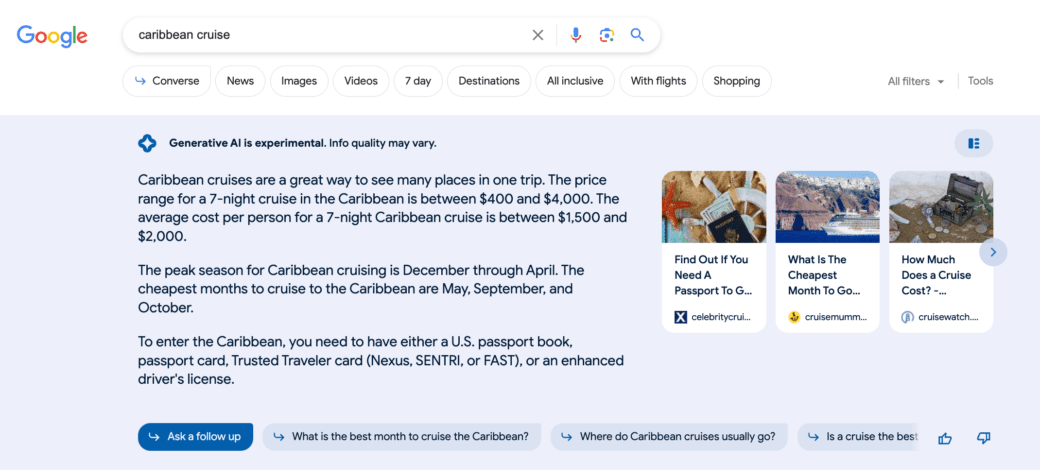
In the next example, instead of offering recognized management training programs, SGE came up with a list of random local businesses, including one that offers CPR training:
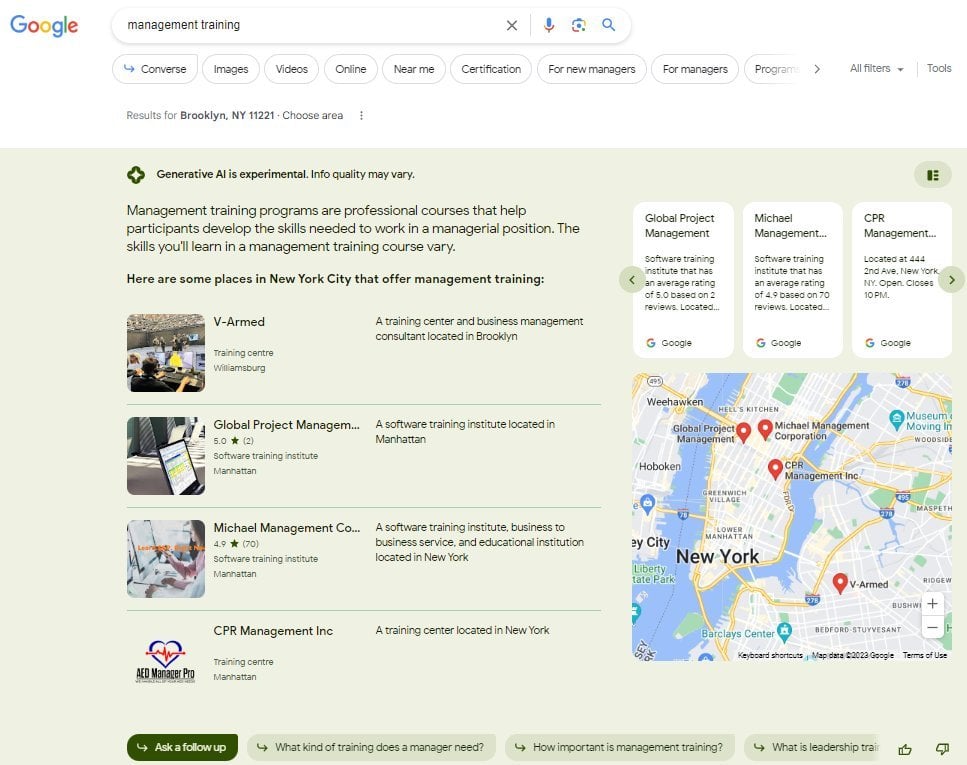
And even though SGE is not supposed to handle sensitive YMYL questions, it sometimes attempts to do so, as shown in the example below:
⚠️Generative Search Experience shouldn’t active for things like air quality (imo)
CC: @searchliaison pic.twitter.com/K4nZIdoZiP
— Britney Muller 🇺🇦 (@BritneyMuller) June 7, 2023
On the bright side, Google’s white paper on SGE clearly states its dedication to providing “reliable, helpful and high-quality information,” with extra attention given to YMYL queries. So, let’s hope that once the model is better trained, there will be fewer instances of AI snippets spreading misleading information.
When will the search generative experience go live?
Google has not disclosed the exact **** for the full-scale rollout of SGE. Still, as noted by Barry Schwartz, based on the information from Search Labs, it is speculated that the SGE experiment will be finished by December 2023.
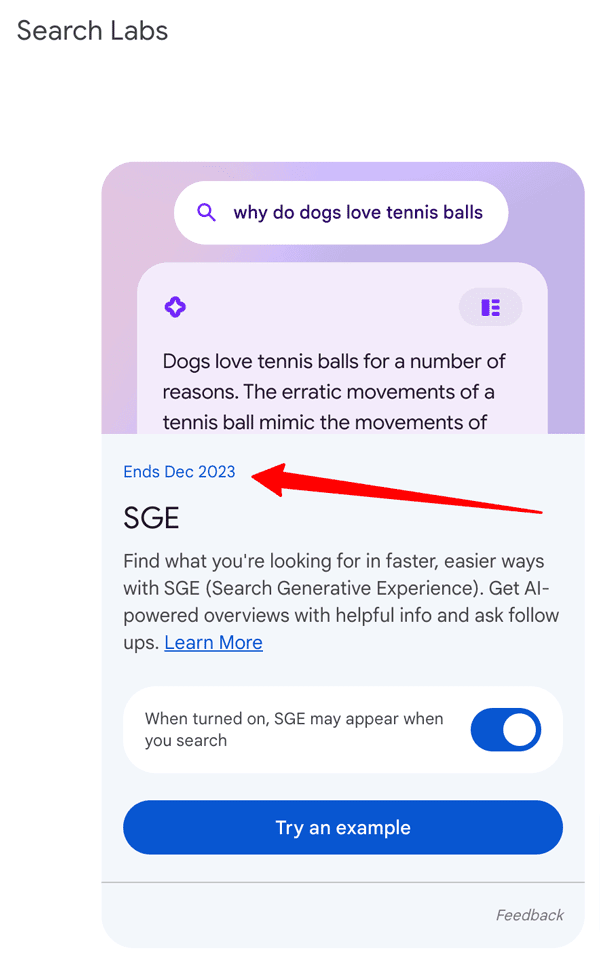
Which industries/types of websites may benefit from the SGE rollout?
It’s still too early to draw definitive conclusions about how exactly the SGE rollout will impact different SEO players. The experiment started only a few weeks ago, many features are still in progress, and things are changing at a fast pace.
Two weeks ago, we started opening up access to SGE. Since then, we’ve made a number of quality updates, including a major improvement that reduces the time it takes to generate AI snapshots by half! We hope everyone testing it out enjoys the speedier experience. If you haven’t…
— Google SearchLiaison (@searchliaison) June 8, 2023
That being said, based on what we can currently see, we can make some tentative assessments about how the future looks so far.
Local businesses may get more traction
According to Kevin Indig’s article on 11 realizations from testing SGE, “local reviews might actually get more traffic from Google based on the SGE beta.”
Barry Schwartz, also mentioned local businesses as potential winners, stating:

Barry Schwartz
CEO of RustyBrick and News Editor at SEL
So it is early but it seems like the local pack results went from 3 listings in the traditional Google search results to 5 listings in the new Google Search Generative Experience. So local businesses may get more visibility with this new experience.
Ecommerce retailers can get more traffic from free product listings
Brodie Clark suggests that ecommerce businesses proficient in managing their product feeds and using structured data have a chance to be featured in the free product listings within AI snapshots. An important observation by Kevin Indig is that these businesses should prioritize product, local and brand reviews, as AI heavily relies on user feedback.
On the other hand, Aleyda Solis projects that product listing pages of established brand retailers may experience a decline in traffic, Google AI snippets take over that role. Moreover, big brands like Nike or North Face may also lose traffic to retailers selling their products since SGE doesn’t seem to favor brand manufacturer websites.
Blogs covering informational queries may lose the lion’s share of traffic
Anastasia Kotsiubynska believes that informational queries are the most vulnerable, especially queries answering who, what, and where questions. With SGE, a lot of users will get the necessary information directly from the SERP’s AI snippet without having to click on any links. Whenever the snippet provides insufficient information to users, the three visible websites in the top-right corner of the snippet may still get some organic traffic.

Anastasia Kotsiubynska
Head of SEO at SE Ranking
Additionally, the top three websites located within the snippet are not the same as the top three ones from a regular organic search–and some of them aren’t even ranking in the top 10 or top 30 regular results. This spells new challenges for SEOs in understanding the new ranking principles, making it harder for them to get into the clickable space of SERPs.
Finally, Anastasia notes that we don’t yet know how much space paid ads will occupy, which can further limit the site’s opportunities to get traffic.
What SEO specialists can start doing now to prepare for the upcoming changes
During the experiment phase of the search experience, gaining first-hand experience with it is crucial. This is expressed clearly in the following quote by Barry Schwartz:

Barry Schwartz
CEO of RustyBrick and News Editor at SEL
Figure out a way to gain access to SGE, even if you are not in a supported country, maybe by using a proxy or VPN. You must play with it and see how it changes over time, because we all think at one point in time, this will replace the main Google.com transitional search results. So I recommend you play with it, if not daily, at least weekly, to see how your client queries will be impacted and what opportunities you can find there to rank well in the AI generative response.
Anastasia Kotsiubynska suggests taking it one step further and to begin preparing your sites for the update:

Anastasia Kotsiubynska
Head of SEO at SE Ranking
We can already check how the new SERPs for our focus queries will look, and analyze patterns like the structure of the snippet, including content structure of the top websites from the snippet. We can even start implementing some of the changes on our websites. Moreover, we should probably reconsider our goals in terms of organic traffic, aiming even more for highly relevant traffic that cannot be easily replaced by the snippet.
